|

HOME |
ABOUT | INDEX |
NEWS |
FACEBOOK |
CONTACT
LESBIAN
Homosexual
Women | Gay Women | Women Loving Women
Lesbian Definition
I am
a lesbian. It does not mean I want to be a man. It does
not mean I hate men. It just means I am happy being a
woman who is attracted to women.
The word
“lesbian” describes a woman who is primarily or
exclusively attracted to or involved
with other women romantically, emotionally, and/or
sexually. As a sexual orientation, it can be
further defined as an innate, enduring, inherent, and
immutable pattern of feelings and behavior in which a
woman has an affectional, romantic, emotional,
spiritual, sensual, and/or sexual affinity or desire for
other women.
Clinically
speaking, it refers to homosexual women. Some women
prefer to use the term "gay." Other
terms related to the word "lesbian" include... Women
Having Sex With Women (WSW) and Women Loving Women
(WLW).
Sexual
orientation is a complex aspect of human identity that
involves an enduring pattern of attraction, and being
lesbian is just one of the various sexual orientations
that exist. It's important to recognize and respect the
diversity of human experiences and identities.
Additionally, it's crucial to approach discussions about
sexual orientation with sensitivity and an open mind, as
people's experiences can vary widely.




"Being a lesbian doesn't make you different, it makes
you uniquely special."
-Jodie Foster
Sapphic Alert: Here's Every Dyke March in the US in 2025
Renee Rapp Presents Award for Power in
Lesbianism
WLW: Making Us Believe in Love Again... Sapphic Love is
Alive and Well
When Abbie Met Emmy: Lesbian Romance
Short Film
No
More Blues by FreenBecky
Lesbian Love Languages
Lesbian Perspective: Hardest Thing About Not Being
Straight
Ten Things Lesbians Hate to Hear
Info: Sexual Orientation
Queer Women Who Changed History
Famous Lesbians
Wikipedia: Definition of Lesbian
Candid Answers to Questions About Lesbian Sex
Tribute to the Women Who
Spoke Up for Lesbian Rights
Honey by Kehlani
Sorry Straights, These Karaoke Songs
Belong to the Lesbians
Curve: Lesbian
Magazine
Lesbian Characters on TV We're Obsessed With
It’s Never Too Late to Become a Lesbian
Lesbian History
Western
society has been simultaneously intrigued and threatened
by women who challenge feminine gender roles
Lesbian as
a concept, used to differentiate women with a shared
sexual orientation, is a 20th-century construct.
Throughout history, women have not had the freedom or
independence to pursue homosexual relationships as men
have, but neither have they met the harsh punishment in
some societies as homosexual men. Instead, lesbian
relationships have often been regarded as harmless and
incomparable to heterosexual ones unless the
participants attempted to assert privileges
traditionally enjoyed by men.
As a result, little in
history has been documented to give an accurate
description of how female homosexuality has been
expressed. When early sexologists in the late 19th
century began to categorize and describe homosexual
behavior, hampered by a lack of knowledge about
lesbianism or women's sexuality, they distinguished
lesbians as women who did not adhere to female gender
roles and designated them mentally ill.
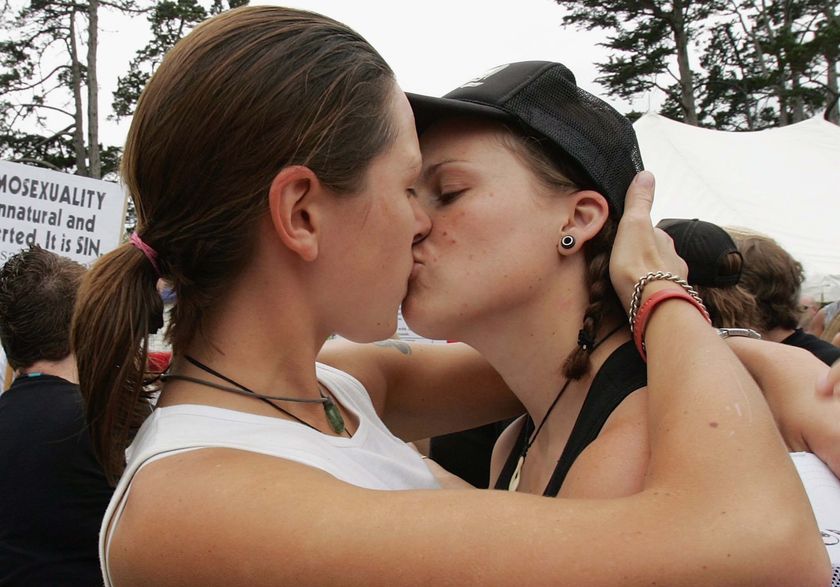


Drew Barrymore Flirts with Taylor Tomlinson
Lesbians Who
Have Made US
Political
History
Miriam Margolyes Identifies as an
Unapologetically Woke Left-Wing Dyke
Lesbians Have More Orgasms Than Straight Women
Video List: Most Famous Lesbians in History
Edie and Amanda: First Time
Info: Sexual Orientation
Best Lesbian Movies Ever Made
Incredible Lesbians Who are Loud, Proud
and Making the World a Better Place
How The L Word Changed Lesbian Television
Endless Love: Audrey and Camille
Famous Black Lesbians You Should Know
Ruth and Jade
Info: Women and Feminism
Most Iconic Lesbian Movies Of All Time
What My Lesbian Relationship Taught Me About
Interdependence
Sam & Mon: Call Out My Name
Metro Station: I Think She Likes Girls
Paige and Holly: Hugs and Cuddles
Awesome Songs About Women Crushing on Women
Lesbian relationships have often been regarded as
harmless
Women in homosexual relationships responded to this
designation either by hiding their personal lives or
accepting the label of outcast and creating a subculture
and identity that developed in Europe and the United
States. Following World War II, during a period of
social repression when governments actively persecuted
homosexuals, women developed networks to socialize with
and educate each other. Greater economic and social
freedom allowed women gradually to be able to determine
how they could form relationships and families. With
second wave feminism and growth of scholarship in
women's history and sexuality in the 20th century, the
definition of lesbian broadened, sparking a debate about
sexual desire as the major component to define what a
lesbian is.
Women generally exhibit greater sexual
fluidity than men and find it easier to become
physically and emotionally intimate with the same sex
than men do. Some women who engage in homosexual
behavior may reject the lesbian identity entirely,
refusing to identify themselves as lesbian or bisexual.
Other women may adopt a lesbian identity for political
reasons. Greater understanding of women's sexuality has
led to three components to identifying lesbians: sexual
behavior, sexual desire, or sexual identity.




WLW: Making Us Believe in Love Again... Sapphic Love is
Alive and Well
100 Lesbian Things To Do Before You Die
Romantic Films All Queer Women Need to Watch
Ten Things Lesbians Hate to Hear
Lesbian Tunes: New Sapphic Pride Anthems
Amy's Coming
Out Story
Celebrity Lesbian Couples We Adore
Info: LGBTQ Community
Things You Should Know Before Having Lesbian Sex for the
First Time
Essential Lesbian
Guide to Flirting
Maze and Eve: Wonderwall
Candid Answers to Questions About Lesbian Sex
Everything You Always Wanted to Know About Lesbian Sex
Movie Scenes: Best Lesbian Kisses
LeSbo
NainA: Pure Leabian Page
Queer Women Who Changed History
It’s Never Too Late to Become a Lesbian
Queer Women with Tantalizingly Sexy Hands
1965 Report: Female Homosexuality
Portrayals
of lesbians in the media suggest that Western society at
large has been simultaneously intrigued and threatened
by women who challenge feminine gender roles, and
fascinated and appalled with women who are romantically
involved with other women. Women who adopt a lesbian
identity share experiences that form an outlook similar
to an ethnic identity: as homosexuals, they are unified
by the discrimination and potential rejection they face
from their families, friends, and others. As women, they
face concerns separate from men. Lesbians may encounter
distinct physical or mental health concerns. Political
conditions and social attitudes also affect the
formation of lesbian relationships and families.

Am I a Lesbian? (Masterdoc)
Paige and Holly: Smash or Pass
Queer Women Who Changed History
Renee Rapp Presents Award for Power in
Lesbianism
When Abbie Met Emmy: Lesbian Romance
Short Film
Video Montage 1: Lesbian Love and Kisses
Gal Pals and Compulsory
Heterosexuality
Slate: Some Young Women Don't Like Lesbian Label
Noora, Are You a Lesbian?
Mental Health Issues Lesbian Women Cope With
Sam & Mon: Earned It
Lesbians Discuss Their First Time With a Girl
Info: Women and Feminism
Late Bloomers: It's Never Too Late to Be a Lesbian
Welcome to the Gay Woman Channel
Metro Station: I Think She Likes Girls
Lesbians Who
Have Made US
Political
History
Incredible Lesbians Who are Loud, Proud
and Making the World a Better Place
Lesbian Highlights of 2022
Paige and Holly: I Wanna Marry You
Lesbian Love Languages
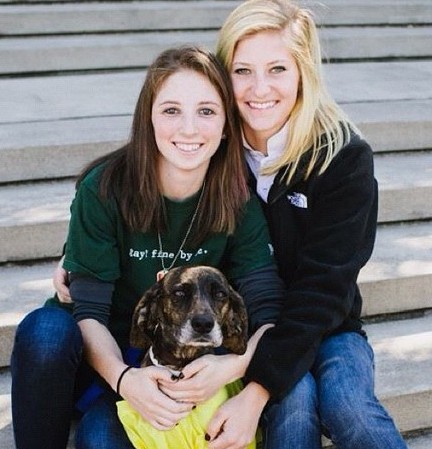

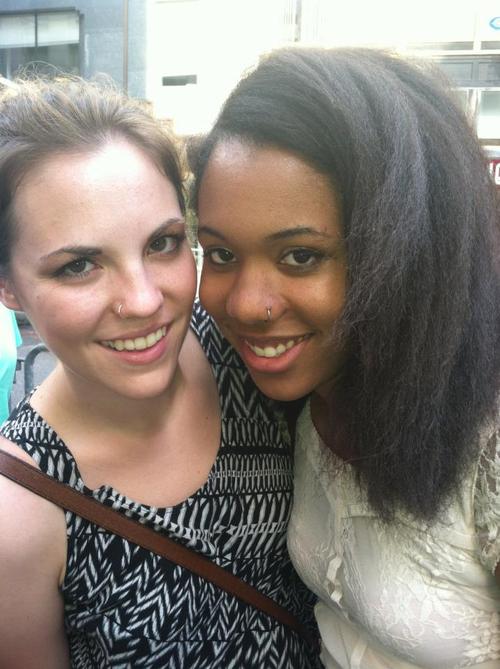
Eat Pray Love
Sapphic religious experience
Being lesbian is a religion. It’s feast, fast, or
famine. It’s on our knees begging at the altar between
her knees. It’s our tribe, our gaggle of gay girls, and
our fighting to be included in some social club, meetup,
Facebook group, marriage rights, equal rights and more,
or hiding in social awkwardness afraid of that demon
called rejection. We portion out our psychic energy and
our daily allotted 24 hours in this religion of being
lesbian and we eat... we pray... we love.
Eat! Help yourself to delicious lesbian
fare. Feel the connection to our global tribe and when
you’re full you can push away from this gorgeous table
of wise women fare to go live. Be about the business of
living and learning; growing and becoming more of your
fabulous and amazing self. The wisdom you consume from
the lives of other's experiences is the fuel that helps
you find direction, meaning, gumption and guts to keep
going. Don’t stop eating lesbian wisdom.
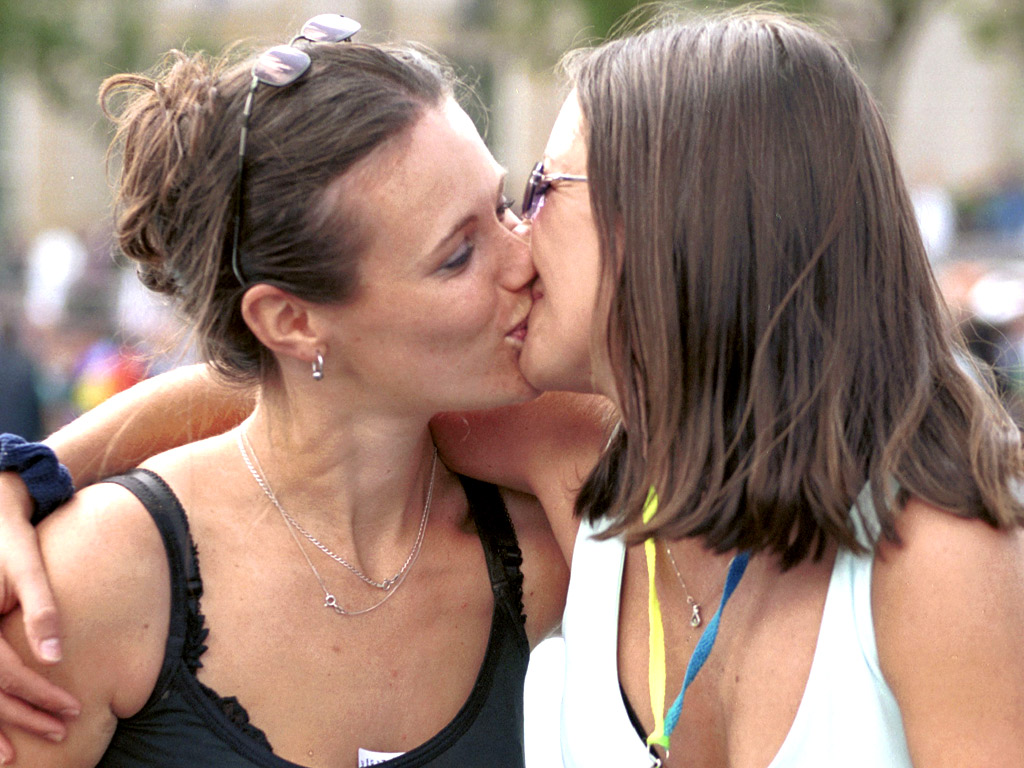


Lesbians Have More Orgasms Than Straight Women
Lesbian Perspective: Hardest Thing About Not Being
Straight
Giving Up My Love of Long Nails?
Miriam Margolyes Identifies as an
Unapologetically Woke Left-Wing Dyke
Info: Women and Feminism
Late Bloomers: It's Never Too Late to Be a Lesbian
Mia and Pauline
What My Lesbian Relationship Taught Me About
Interdependence
Lesbian Characters on TV We're Obsessed With
Essential Lesbian Guide to Flirting
Best Lesbian Movies Ever Made
Things You Should Know Before Having Lesbian Sex for the
First Time
Drew Barrymore Flirts with Taylor Tomlinson
Epic Journey to America's Last Lesbian Bars
Queer Women Who Changed History
It’s Never Too Late to Become a Lesbian
Advocate Magazine: Women of the Year
Butches and Studs
100 Lesbian Things To Do Before You Die
Ruthie Berman: Pioneering Lesbian Shares
Her Epic Love Story
Curve: Lesbian
Magazine
Pray! On our knees, we pray for a great
relationship, we pray for equal rights, we pray for
those women we want and don’t have. We pray about the
one we do have wishing she might be this or that. We
pray and rejoice when that ecstatic feeling of love
shows up pulling back the covers on our dreams. We pray
in our loneliness to find someone. We pray in our pain
to let go of the one who isn’t ours anymore. We pray to
move on. We pray to find sense in the world. We find the
prayer of laughter, the prayer of thoughtfulness, the
prayer of found love, the prayer of experience making,
the prayer of failed love, the prayer of faith in the
goodness of life. Don’t stop praying.
Love! The more time you spend traveling
the country and meeting lesbians from all over the
world, the more you are confirmed that lesbian culture
is messy, full of drama, alive with misunderstandings,
misplaced egos, failed dreams, good and bad
relationships and the more you love it. We are as human
and common in our foibles as any straight folks can be
and we are as uniquely special in our love as every
individual human being is. Lesbian love is messy but
more important is that our love is powerful. It’s life
changing and we need more of it. The world needs more of
our lesbian love. Don’t stop seeking to create more
lesbian love.
Eat, pray, love. Lesbian, be proud. Have no
shame. Embrace it, be it, share it. The religion of
being lesbian.
[Source: Mary Gorham Malia, Founder of Gay Girl Dating
Coach, Gay Girl Love Tour, and Live Your Best Lesbian
Life Global Telesummit]

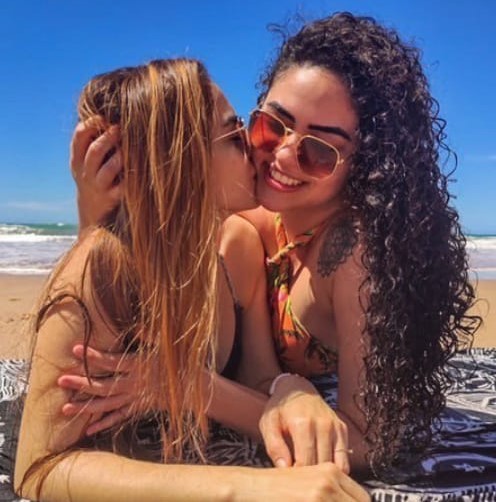
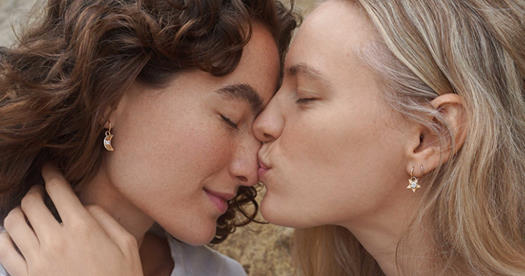
Am I a Lesbian? (Masterdoc)
Karine Jean-Pierre Hosts L Word Cast
at White House Press Briefing
Lesbian Highlights of 2022
Cynthia Nixon: Why She
Identifies as Queer
Am I Really Proud to Be a Lesbian?
Epic Journey to America's Last Lesbian Bars
Nobody by Jade Novah and Cynthia Erivo
Edie and Amanda: First Time
Sam & Mon: Romantic Scenes
Awesome Songs About Women Crushing on Women
Game-Changing Queer Women to Celebrate
Women's History Month
Commentary: Why I Am
Nobody's Wife
XtraMagazine: No, Lesbians
Are Not Disappearing
Best Lesbian Scenes from Movies
Mia & Pauline
Queer Women Who Changed History
Endless Love: Audrey and Camille
Video Montage 3: Lesbian Love and Kisses
Gay Girl
Dating Coach
Video: Famous Lesbians
1965 Report: Female Homosexuality
Incredible Lesbians Who are Loud, Proud, Making the World a Better Place
Famous Lesbians
|
Melissa
Etheridge (Music)
Billie
Jean King (Athletics)
Ellen
DeGeneres (Media)
Annie
Leibovitz (Arts)
Sally Ride
(Science)
Lily
Tomlin (Film, TV)
Lori
Lightfoot (Politics)
Brandi
Carlile (Music)
Margaret
Cho (Entertainment)
Jodie
Foster (Film)
Gertrude
Stein (Literature)
Suze Orman
(Finance)
Robin
Roberts (Media)
Amy
Ray (Music)
Emily
Saliers (Music)
Susan Sontag (Literature)
Tig Notaro (Entertainment)
 |
Martina Navratilova (Athletics)
Cynthia Nixon (TV)
Wanda Sykes (Entertainment)
Susan Love (Science)
Jane Lynch (Film, TV)
Amy
Ray (Music)
Jeanne Marrazzo (Science)
Emily
Saliers (Music)
Alison Bechdel (Arts)
Tammy Baldwin (Politics)
Rachel Maddow (Media)
KD
Lang (Music)
Brittany Griner (Athletics)
KD
Lang (Music)
Mary Oliver (Literature)
Ariana DeBose (Film)
Audre Lorde (Literature)
Stephanie Miller (Entertainment)
 |
Karine Jean-Pierre (Politics)
Kelly McGillis (Film)
Alice Walker (Literature)
Hayley Kiyoko (Music)
Hannah Gadsby (Entertainment)
Beth Ford (Business)
Mary
Lambert (Music)
Rose O'Donnell (Film)
Annise Parker (Politics)
Ani
DeFranco (Music)
Kate
McKinnon (Film, TV)
Kate
Pierson (Music)
Liat Ben-Zur (Business)
Cindy
Wilson (Music)
Neicy Nash (TV)
Renee Rapp
(Music)
Mariam
Margolyes (Film)
 |

Renee Rapp Presents Award for Power in
Lesbianism
Lesbians Who
Have Made US
Political
History
Origin of the Word Lesbian
Queer Women Who Changed History
Am I a Lesbian? (Masterdoc)
When Abbie Met Emmy: Lesbian Romance
Short Film
WLW: Making Us Believe in Love Again... Sapphic Love is
Alive and Well
It’s Never Too Late to Become a Lesbian
Old Lesbians Give Advice to Young Lesbians
Cathy's Coming Out Story
Video List: Most Famous Lesbians in History
Breanne Williamson: I Am a Lesbian
Queer Girls Googling
Drew Barrymore Flirts with Taylor Tomlinson
Epic Journey to America's Last Lesbian Bars
Most Iconic Lesbian Movies Of All Time
Queer Women with Tantalizingly Sexy Hands
Epochalips: Smart
Lesbian Commentary
Lesbian Love Languages
Sapphic
A
Sapphic person is a woman, or woman-aligned person who
is attracted to other women or woman-aligned people. A
Sapphic person is also known as Woman Loving Woman (WLW).
They may
or may not be attracted to other genders as well. This
attraction does not need to be exclusive, as the label
is used as a way to unify all women who love other women
such as, lesbians, bisexual women, pansexual women,
promoting solidarity among women of all identities.
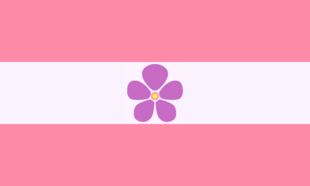
Exploring Sapphic Herstory
Sapphic:
An Explanation
The term is most commonly used as an umbrella term. It's
typically used in combination with another identity to
specify that one prioritizes their attraction to and
relationships with other women. It is sometimes used as
an identity on its own for people who know they are
attracted to women but may be uncertain if they're
attracted to other genders. The term can also be used to
describe a relationship between two women.
The word sapphic comes from the name of the Greek poet
Sappho. The island she was born on, Lesbos, is where the
word lesbian is derived from. The masculine counterpart
to sapphic is achillean. The non-binary counterparts are
diamoric and enbian.
What Does It Mean to Be Sapphic?
Lesbians You'll Date Before You Die
Miriam Margolyes Identifies as an
Unapologetically Woke Left-Wing Dyke
Biggest Lesbian Party in the World
Famous Black Lesbians You Should Know
Noora, Are You a Lesbian?
Dyke vs Lesbian
What My Lesbian Relationship Taught Me About
Interdependence
Women Who Changed the Course of LGBTQ History
Music Video: I Wish You Were Gay
Breanne Williamson: I Am a Lesbian
Queer Girls Googling
Things You Should Know Before Having Lesbian Sex for the
First Time
Carmilla and Laura: Beautiful Moments
Best Lesbian Movies Ever Made
Lesbians Have More Orgasms Than Straight Women
Redefining Butch-Femme Relationships
Paige and Holly: Hugs and Cuddles
Lesbian Characters on TV We're Obsessed With
Endless Love: Audrey and Camille
Lesbians Who
Have Made US
Political
History
Pressures of
Being a Lesbian
They hate men? They have daddy issues?
They're scary masculine?
Lesbian women face unique mental health issues (in
addition to the ones all members of the LGBTQ community
face) because they exist in a marginalized section of an
already marginalized community. Exploring the effects of
discrimination and prejudice only scratches the surface
of their mental health challenges.

 


Curve: Lesbian
Magazine
Butches and Studs
1965 Report: Female Homosexuality
My First Date With a Girl
Queer Women Who Changed History
Things Lesbians are Tired of Hearing
BuzzFeed: Lesbian Stereotypes
Welcome to the Gay Woman Channel
Info: Skirt Club
Healthy Place: Myths About Lesbians
Sam & Mon: Love Me Like You Do
Jess Steven: Too Pretty to Be a Lesbian
Queer Girls Googling
Say I Love You
Paige and Holly: I Wanna Marry You
Lesbian Dating 101
More so than other members of the LGBTQ community,
lesbian women feel pressure to identify and label
themselves with terms they are not necessarily
comfortable with. This pressure comes from
heterosexuals, gay men, the gay bar scene, on-line
dating sites, the media and other lesbian women. Terms
like Femme, Alpha, Butch, and Lipstick Lesbian can be
frustrating for some lesbian women.
Even the
word “lesbian” can be controversial. Should we say
“lesbian,” “lesbian women,” “gay women” or maybe
something else? There isn’t a correct answer or anything
close to a consensus in the lesbian community. These
identity and labeling issues cause stress and contribute
to the social isolation lesbian women deal with.
“Feminist” is another label people pressure lesbians to
consider. There are historical and current conflicts
between lesbian feminism, mainstream feminism and
radical feminism. This makes many lesbian women
reluctant to engage in the conversation of feminism or
consider feminism part of their identity.

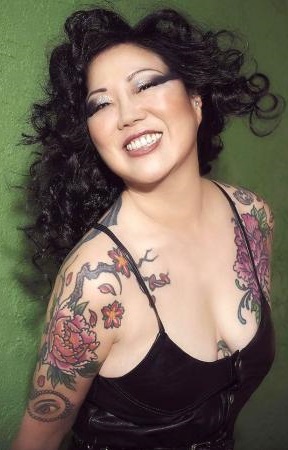



People (usually heterosexuals) often make several
assumptions about lesbian women that contribute to
unwelcomed stereotypes: They hate men. They have “daddy
issues.” They are more masculine than heterosexual
women. Men molested them as children. There needs to a
be a “man” in a lesbian relationship. Lesbians haven’t
met the right man yet. Lesbian sex doesn’t count as
“real sex.” Lesbians dress like men. Lesbians are not
physically attractive. They are more interested in
sports. They drive SUVs. They push commitment and
establish their romantic relationships too quickly. They
are “crazy.”
They are trying being with women as some sort of trendy
experiment rather than a legitimate sexual preference.
Am I a Lesbian? (Masterdoc)
Renee Rapp Presents Award for Power in
Lesbianism
WLW: Making Us Believe in Love Again... Sapphic Love is
Alive and Well
When Abbie Met Emmy: Lesbian Romance
Short Film
Epic Journey to America's Last Lesbian Bars
Gal Pals and Compulsory
Heterosexuality
Lesbian Insights: Sexual Activity in 1966
Sam & Mon: Call Out My Name
Gal Pals and Compulsory
Heterosexuality
Info: Women and Feminism
Most Iconic Lesbian Movies Of All Time
It’s Never Too Late to Become a Lesbian
How The L Word Changed Lesbian Television
Video Montage 5: Lesbian Love and Kisses
How Do You Know You're a Lesbian
Mia & Pauline
No
More Blues by FreenBecky
Lesbian Love Songs: Women Singing About Women
Mermaid Tavern
What Does It
Mean to Be Sapphic?
Queer
Women...
I love identifying as a sapphic woman because for one,
it sounds fancy AF. For another, the derivative of the
word — which we will get to in a minute — is as poetic
as my love for femmes can feel.
There have been points in my life where I have felt more
comfortable identifying as “bisexual,” while at other
times I have preferred “lesbian.” Regardless of the
label, it is my sapphic love that has remained constant.
Sapphic is also a less-often used term in the queer
community, so if you’re wondering what I mean by “sapphic,”
you’re not alone. Prior to 2020, I couldn’t confidently
define it despite being openly queer.
What I’ve learned since is that while “sapphic” and
“lesbian” are related terms, they are distinct from one
another.


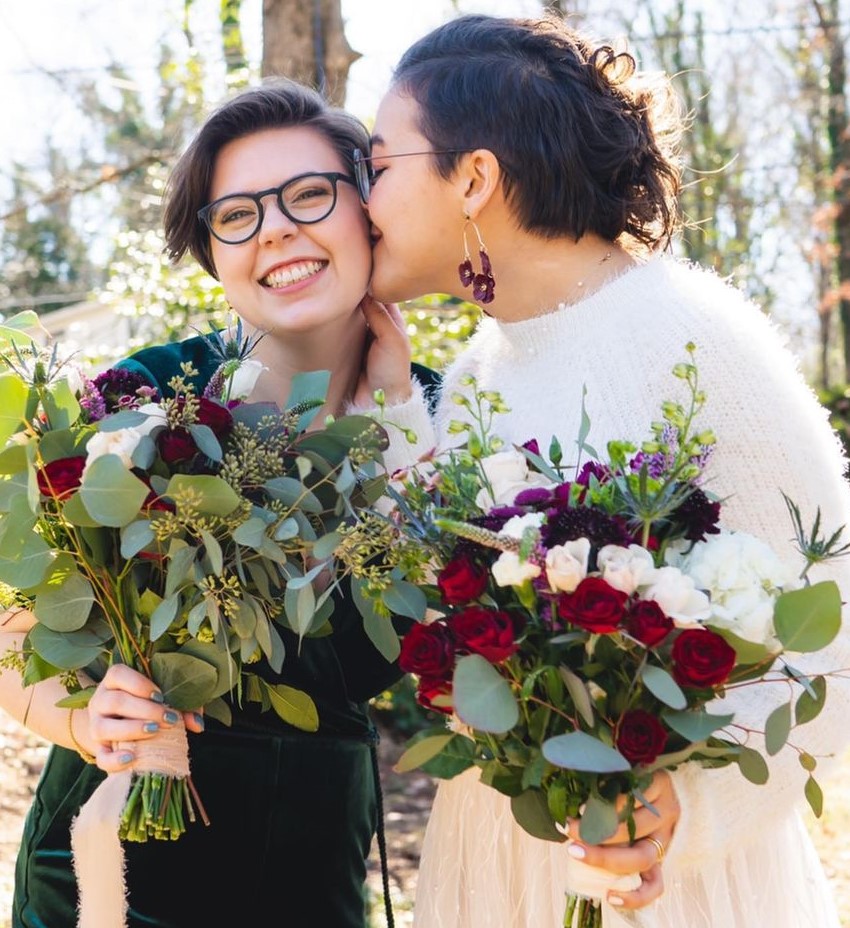
Why Lesbian Visibility Matters
Advocate: Salute to Amazing LGBTQ Women of 2021
Lesbian Proposal: COVID Edition
Miriam Margolyes Identifies as an
Unapologetically Woke Left-Wing Dyke
Kathryn's Coming Out Story
Lesbian Love Languages
Lesbians Have More Orgasms Than Straight Women
Curve: Lesbian
Magazine
Best Lesbian Movies Ever Made
Things You Should Know Before Having Lesbian Sex for the
First Time
Breanne Williamson: Why I Hate the Word Lesbian
Jess Steven: Too Pretty to Be a Lesbian
Candid Answers to Questions About Lesbian Sex
Butches and Studs
Lesbian Dating Tips: How to Flirt With a Girl
Photo Celebration: 30 Years of World's
Largest Lesbian Party
Awesome Songs About Women Crushing on Women
Umbrella
Term...
Sapphic is
an umbrella term that includes lesbian, bisexual, and
pansexual trans femmes, mascs, nonbinary folks, and cis
women. Yet unlike these sexualities, "sapphic" strives
to conjure an experience more akin to an intention
toward attraction — one oriented less to any specific
gender identity and more to the fullness of a potential
lovers' humanity.
The term sapphic has a long history, one that dates all
the way back to ancient Greece, and has become an
umbrella word that refers to a wide spectrum of
sexualities and genders. If you want to learn more about
sapphic love and its intertwined history with lesbian
identity, read on!
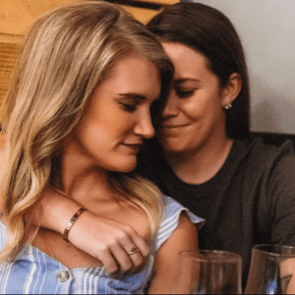


Noora, Are You a Lesbian?
Everything You Always Wanted to Know About Lesbian Sex
Multicouple Lesbian Fanvid: Cosmic Love
Lesbian Characters on TV We're Obsessed With
Paige and Holly: Our First Time
Info: Skirt Club
Drew Barrymore Flirts with Taylor Tomlinson
Gal Pals and Compulsory
Heterosexuality
Lesbians Who
Have Made US
Political
History
Slate: Some Young Women Don't Like Lesbian Label
L Word Generation Q:
Season Two Premiere (Entire Episode)
Cute Lesbian Couple: Daily Life in Quarantine
Women Who Changed the Course of LGBTQ History
Sufi
and Anjali: Annoying Each Other During Quarantine
Lesbian Couple Holds Pandemic Wedding at Drive-In Movie
Theatre
WLW: Making Us Believe in Love Again... Sapphic Love is
Alive and Well
What Does It Mean to Be Sapphic?
At its
core, sapphics can be lesbians, bisexuals, and pansexual
people of a variety of genders. Trans femmes, mascs,
nonbinary people, and cis women can all fall under the
sapphic umbrella if the term resonates with them.
Being sapphic can mean different things to different
people, and can depend on whom you ask within the
community.
Victoria Williams, who discusses being sapphic on TikTok,
says that for her, being sapphic is a culmination of her
love for not only all women, but her woman. “In my
relationship, I have romanticized my own sapphic love
beyond words,” Williams told Them. “I’ve memorized her
from head to toe, freckle to dimple. I’ve read, taken
notes and devoured her heart and soul.”
The peer-led sex education advocate Katie Haan told Them
that being sapphic means having a “community where
everyone has a mutual understanding of what it means to
experience attraction, love, sexual desire, romance,
community, friendship, companionship, inspiration and
creativity through a similar lens, on our terms.”
It’s important to remember that not all queer people are
sapphic. Being a queer person means using whichever
phrases work best for you, so if sapphic doesn’t feel
right, you don’t have to claim it.

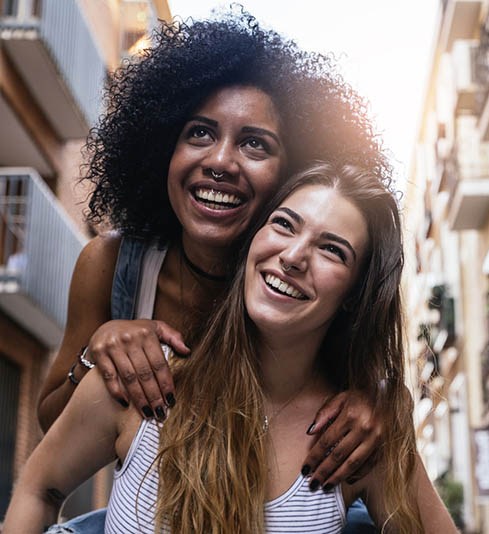

She Likes Girls
Sam & Mon: Love Me Like You Do
Info: Skirt Club
What My Lesbian Relationship Taught Me About
Interdependence
Queer Women with Tantalizingly Sexy Hands
1965 Report: Female Homosexuality
Best Lesbian Scenes from Movies
You Tube: Notable Lesbians
Info: LGBTQ Community
New Research: Lesbians More Accepted Than Gay Men
Music Video: I Wish You Were Gay
It’s Never Too Late to Become a Lesbian
When Abbie Met Emmy: Lesbian Romance
Short Film
Renee Rapp Presents Award for Power in
Lesbianism
When Did the Term Sapphic Become Popular?
According
to Merriam-Webster, the term sapphic derives from the
Greek goddess Sappho, who notoriously resided on the
Isle of Lesbos (love that for us WLW).
Sappho was an incredibly popular poet whose work
explored desire and love, specifically the kind that
exists between two women. As a result, the women of
Lesbos were said to prefer each other — hence, the
origin of the term lesbian.
After a few scrolls of Sappho’s poems were discovered in
the late 1800s, “sapphic” became an adjective to
describe women whose emotional and sexual preferences
were other women. It wasn't until the 1950s, however,
that “sapphic” became a popular term to describe women
who loved women in the US.
In recent years, sapphic has evolved to be more
inclusive, expanding beyond being a woman attracted to
women. The modern community of sapphics offline and in
online spaces like TikTok is vast, including nonbinary
transmascs and trans femmes, trans men, and women of
many sexualities. “Sapphic” has become less about the
gender of who one is attracted to and is more a vibe of
queer love.
“It has slowly evolved into a safe word that, when
spoken, just lets you feel comfort in knowing that you
are in the company of other like-minded individuals,”
Williams said.




Curve: Lesbian
Magazine
Breanne Williamson: I Am a Lesbian
Lesbian Perspective: Hardest Thing About Not Being
Straight
Video: Girl Picking Up Girls
Best Lesbian Movies Ever Made
Things You Should Know Before Having Lesbian Sex for the
First Time
BuzzFeed: Lesbian Stereotypes
Video Montage 2: Lesbian Love and Kisses
Butches and Studs
Candid Answers to Questions About Lesbian Sex
Lesbians Have More Orgasms Than Straight Women
Miriam Margolyes Identifies as an
Unapologetically Woke Left-Wing Dyke
Lesbians Who
Have Made US
Political
History
Hottest Lesbians Streaming on TV Right
Now
Sapphic vs Lesbian...
While many
lesbians claim sapphic identity, it’s important to note
that there is a distinction between being a lesbian and
being sapphic. While lesbians can be sapphics, not all
sapphics are lesbians.
Sapphics can be bisexual, pansexual, and omnisexual
people of many genders. The term goes beyond sexuality
and the gender of the person one is attracted to.
Rather, it encompasses a spectrum of genders and
sexuality and captures love rooted in one’s full
humanity.
There can be overlap, but the two terms are not
interchangeable.
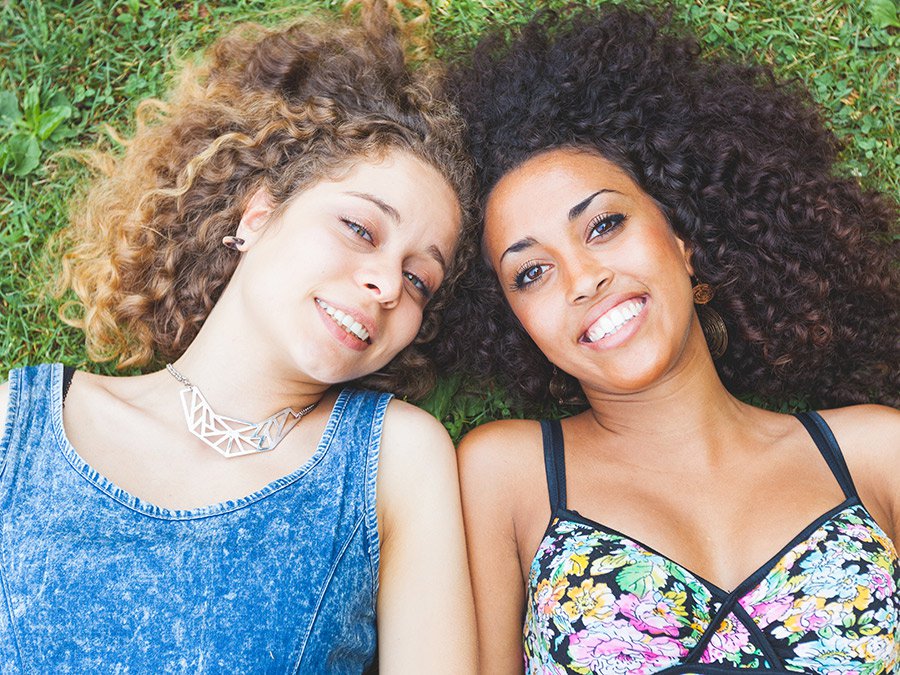

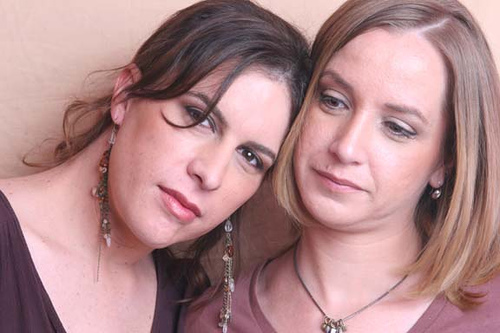
Jill's Coming Out Story
How The L Word Changed Lesbian Television
Iris and Mardou: I Get to Love You
Info: Skirt Club
Lesbian Couples: Somewhere Only We Know
Music Video: Girl Crush
Queer YouTubers: Losing Your Virginity
1965 Report: Female Homosexuality
Can Trans People Be Sapphic?
The only people saying trans people can’t be sapphic are
trans-exclusive to begin with. Sapphics can be trans
femmes, trans mascs, nonbinary people, and cis women of
all sexual orientations. What matters is feeling that
the term suits you.
“Sapphic is gender expansive,” sex educator Tia Freeman
told Them. “It strips away rigid control of how someone
is ‘supposed’ to present and at its root embraces love.”
However, it’s important to understand that as with all
identity labels, just because trans people can be
sapphic doesn’t mean all trans people are sapphic. As
always, it’s best to never assume a person’s identity
and ask if they feel sapphic suits them before using it.
When I was in the throes of figuring out my sexual
orientation throughout adolescence, and even in my
college years, sapphic felt like a term that was
welcoming and broadly encompassing. It seems almost
impossible that I have identified as anything else.
For me, sapphic evokes the soulful, “I want a cottage
core lifestyle on a farm with just us” type of emotions
that I feel for my femme partner. It reflects the
intensity of the crushes on girls I had in high school
that blossomed deep in my chest before I could find the
right language to describe them.
Sapphic is a word that resides on an island outside of
the world of binaries and chooses deep connection with
another queer person. It’s an identity I’ve found a home
within — and maybe one that you can, too.
[Source: Yasmine Hamou, Them Magazine, April 2022]




Lesbian Love Languages
Jess Steven: Too Pretty to Be a Lesbian
Short Film: To My Future Girlfriend
Drew Barrymore Flirts with Taylor Tomlinson
Incredible Lesbians Who are Loud, Proud
and Making the World a Better Place
Lesbians Discuss Their First Time With a Girl
Queer YouTubers: Losing Your Virginity
Info: Women and Feminism
WLW: Making Us Believe in Love Again... Sapphic Love is
Alive and Well
Redefining Butch-Femme Relationships
Honey by Kehlani
Hottest Lesbians Streaming on TV Right
Now
Everything You Always Wanted to Know About Lesbian Sex
Video Montage 4: Lesbian Love and Kisses
Am I a Lesbian? (Masterdoc)
Lesbians Who
Have Made US
Political
History
Lesbian Characters on TV We're Obsessed With
Gay Girl
Dating Coach
Mermaid Tavern
The L Word
"Lesbian"
isn't a dirty word and more millennials need to use it.
The straight male world has convinced young women the L
word is a slur.
Some gay women do not feel comfortable calling
themselves a lesbian. From a social perspective,
the idea of being a woman not attracted to men can be
initially terrifying. There’s the idea of having to
overcome a multitude of social obstacles, from being
stared at when you walk hand-in-hand with the person you
love to having to wonder how you’re going to have
children. The same is true for men who find themselves
only attracted to men. But why do many millennial men
appear comfortable calling themselves "gay," while
millennial women shun the term "lesbian"?
It has been observed that many millennial girls who have
romantic and sexual feelings only toward other women use
the terms “gay” or “queer,” while running away from
“lesbian.” Perhaps society has told us that “lesbian” is
a bad word.




Wikipedia: Definition of Lesbian
Queer Women Who Changed History
Honey by Kehlani
Ten Things Lesbians Hate to Hear
Info: Women and Feminism
What My Lesbian Relationship Taught Me About
Interdependence
Ally and Sam
When Abbie Met Emmy: Lesbian Romance
Short Film
Queer Girls Googling
Lesbians Have More Orgasms Than Straight Women
Petra and Jane: I Love You
Why Being a Lesbian is Amazing
Giving Up My Love of Long Nails?
You Tube: Notable Lesbians
Juliana and Valentina: Say it Again
Lesbian Dating Tips: How Can You Tell If a Girl Likes
You
Curve: Five Types of Lesbians
Jess and Emily: How Lesbians Do It
Awesome Songs About Women Crushing on Women
The word "lesbian" has been villainized in the media
because lesbians serve no purpose to the people who
control it. A 2017 University of Southern California
study showed that 96 percent of the top 100 movies made
in the past 100 years were directed by men, while a 2016
study from Variety showed that almost 80 percent of
showrunners for new scripted shows were men.
The result is two lesbian stereotypes becoming visible
in movies and television — that of the oversexualized,
two-dimensional woman who serves only to satisfy some
pornographic fantasy of a straight man, and that of a
bland, largely disinteresting woman who serves just as
hollow a purpose. The former is the projection of the
only way a lesbian can serve as meaningful to a straight
man, and the latter is the straight man’s reaction to a
woman being completely uninterested in him sexually by
making her as boring and unimportant to the plot as
possible.
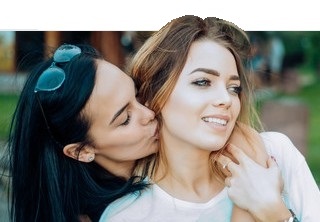


At its root, lesbianism represents something beautiful.
Being a woman attracted to women. Being a woman who can
only fall in love with other women. That used to be
something terrifying. Now it is exciting.
The label
“lesbian” does not have to be what the media has molded
it into. Accepting that you don’t have any attraction to
men is not something that should feel limiting and
scary. Once you accept and understand it, being a
lesbian is something that can open you up to so many
different possibilities, including a community ready to
embrace you.
"Lesbian" is a word that represents something beautiful,
and the more girls and women feel comfortable using it,
the harder it’s going to be for the world to villainize
an identity rooted in love.
[Source: Mary Grace Lewis, Advocate Magazine, July
2018]
Lesbian Couples Frolicking: I See You
Sam & Mon: Earned It
Lesbians Discuss Their First Time With a Girl
Casey and Izzie: Feel Real
Hottest Lesbians Streaming on TV Right
Now
Queer YouTubers: Losing Your Virginity
Info: LGBTQ Community
Lesbian Creators We're Obsessed With
Short Film: To My Future Girlfriend
1965 Report: Female Homosexuality
Lesbians You'll Date Before You Die
Jess and Emily: How Lesbians Do It
100 Years of Lesbianism
Lesbian Dating 101
Slate: Some Young Women Don't Like Lesbian Label
Jezebel: Girl's Guide to Lesbian Clichés and Stereotypes
Paige and Holly: How We Became Girlfriends

Lesbian Dating 101
Emily and Sue: Shameless
Essential Lesbian Guide to Flirting
Ten Things Lesbians Hate to Hear
Mia & Pauline
Sultriest Lesbian and Sapphic Femmes in
TV and Film History
Women Who Changed the Course of LGBTQ History
Video Montage: Best Lesbian Kisses
Mental Health Issues Lesbian Women Cope With
Info: Sexual Orientation
Mermaid Tavern
How The L Word Changed Lesbian Television
Belly Kisses by Rachel Wiley
Jezebel: Girl's Guide to Lesbian Clichés and Stereotypes
Wikipedia: Definition of Lesbian
Lesbians More
Accepted Worldwide Than Gay Men
Research on gender norms
A new study exploring the attitudes toward
nonheterosexual men and women in 23 Western and
non-Western countries found lesbians are more accepted
than gay men around the world. “We found that gay men
are disliked more than lesbian women in every country we
tested,” according to the study, which was conducted by
three New York University psychologists and published in
the December 2019 issue of the journal Social Psychology
and Personality Science.
Sexual minorities face pervasive discrimination and
hostility globally, with same-sex sexual activity still
illegal in approximately 70 countries. Broadly, the
study found that “attitudes toward sexual minorities are
robustly related to beliefs about the gender system,
more broadly.”
The study defines “gender norms” as “widely shared
societal and cultural beliefs distinguishing personality
traits, behaviors, and interests as appropriate and
desirable for either men or women but not both.” It says
that gender norms “prescribe behaviors that fuel a
heteronormative system — that is, men and women
conforming to norms are seen as ‘complements’ to one
another, and this makes heterosexual coupling seem
necessary and normal.”




Queer Women Who Changed History
Noora, Are You a Lesbian?
Ellia and Cassie
Paige and Holly: Smash or Pass
Video Discussion: My First Relationship With a Woman
My
Dear Friend
Hottest Lesbians Streaming on TV Right
Now
It’s Never Too Late to Become a Lesbian
You Tube: Notable Lesbians
Best Lesbian Movies Ever Made
Make Me Complete
When Abbie Met Emmy: Lesbian Romance Short Film
100 Lesbian Things To Do Before You Die
Paige and Holly: Our First Time
Multicouple Lesbian Fanvid: Cosmic Love
Info: Women and Feminism
Epic Journey to America's Last Lesbian Bars
Lesbian Creators We're Obsessed With
In places like the Netherlands where people are more
accepting of gender norm violations, better known as
gender nonconformity, there is an association with
“positive attitudes toward sexual minorities.” The
converse is also largely true: For instance in America,
college students who endorsed “traditional gender
arrangements” were more likely to report negative
attitudes toward gays, lesbians and bisexuals.
Maria Laura Bettinsoli, the study's lead author, said
she and her colleagues were surprised "at the
consistency of the relationship between gender norm
endorsement and sexual prejudice. Even though there were
some non-Western countries that did not conform to the
pattern, the majority of countries did."
Indeed, in countries including China and India, the
survey found that strong gender norms are actually
associated with greater tolerance of homosexuality —
that is, people with the strongest beliefs in how men
and women should behave were more likely to tolerate
homosexuality, the opposite of the West, including the
Americas and Western Europe. The report speculates that
in some Eastern countries, “both gender norms and
nonheterosexuality are considered ‘Western’ (or,
perhaps, capitalist) concepts, and those who are
pro-Western are more likely to feel favorable toward
both.”




Dyke vs Lesbian
Ten Things Lesbians Hate to Hear
Franky and Bridget: Love Me Like You Do
Renee Rapp Presents Award for Power in
Lesbianism
Miriam Margolyes Identifies as an
Unapologetically Woke Left-Wing Dyke
Best Lesbian Vampire Movies
Info: Skirt Club
Drew Barrymore Flirts with Taylor Tomlinson
Sam & Mon: Romantic Scenes
Queer Women with Tantalizingly Sexy Hands
Essential Lesbian Guide to Flirting
Butches and Studs
WLW: Making Us Believe in Love Again... Sapphic Love is
Alive and Well
Why Being a Lesbian is Amazing
No
More Blues by FreenBecky
Lesbian Love Languages
Awesome Songs About Women Crushing on Women
Curve: Lesbian
Magazine
Mermaid Tavern
Men
vs. Women
The study’s findings also suggest that “men are more
likely to be both the targets and perpetrators of sexual
prejudice.” In all 23 countries studied, the report
found "gay men are rated more negatively than lesbian
women,” and that trend was almost entirely driven by the
views of men, except in Poland, Hungary and Russia,
where women also assigned gay men high negative ratings.
In the United States, men who are anti-gays largely
direct their prejudice toward gay men, while women who
are anti-gays direct their prejudice more equally toward
gay men and gay women, the study found.
“In other words, harboring prejudicial attitudes toward
sexual minorities is part of the social construction of
what it means to ‘be a man’” in many Western countries,
according to the report.
In January 2019, the American Psychological
Association’s first guide to issues specific to men and
boys warned that “traditional masculinity ideology”
(what some characterized as “toxic masculinity”)
“has been shown to limit males’ psychological
development, constrain their behavior, result in gender
role strain and gender role conflict and negatively
influence mental health and physical health” and linked
it to both homophobia and misogyny.
Nick and Benedetta
Welcome to the Gay Woman Channel
Endless Love: Audrey and Camille
Sultriest Lesbian and Sapphic Femmes in
TV and Film History
Lesbian Couples: Somewhere Only We Know
Music Video: Love on Fire
Curve: Five Types
of Lesbians
What My Lesbian Relationship Taught Me About
Interdependence
Lesbian Tunes: New Sapphic Pride Anthems
Lesbian Creators We're Obsessed With
Girl on Girl: What's So Scary About Female Pleasure?
Epochalips: Smart Lesbian Commentary
Petra and Jane
Hottest Lesbians Streaming on TV Right
Now
Giving Up My Love of Long Nails?
Lesbian Dating 101




Global
Snapshot
The study
also shed light on some contours of global homophobia.
In Russia, perhaps unsurprisingly due to its 2013 gay
propaganda law, “positive attitudes toward sexual
minorities” are the lowest of the 23 countries surveyed.
A 2018 survey conducted in Russia found that nearly two
thirds of people there believe that LGBTQ people are
seeking “to destroy the spiritual values generated by
Russians, through the propaganda of nontraditional
sexual relations.”
It also placed American attitudes toward lesbian, gay
and bisexual people in the context of other countries
around the world: Argentina, Australia, Belgium, Canada,
Great Britain, Spain and Sweden all have more positive
attitudes toward sexual minorities than do Americans.
Respondents in Brazil, China, Hungary, Japan, Peru,
Poland, Russia, South Africa, South Korea and Turkey all
reported more negative attitudes toward gay people than
the US, while attitudes in France, Germany, Italy, and
Mexico largely mirrored America’s.
In conclusion, the study's authors underscored the
"important phenomenon" uncovered in their report
regarding the differing views of gender norms in the
East and the West and how they relate to views on
sexuality.
"This work should be a springboard for more focused
inquiries into conceptualization of gender and sexuality
in understudied populations and to rethink how these
things are conceptualized in the Western world," the
study stated.
[Source:
Tim Fitzsimmons, NBC News, January 2020]
You Tube: Notable Lesbians
Info: LGBTQ Community
Women Who Changed the Course of LGBTQ History
New Research: Lesbians More Accepted Than Gay Men
Music Video: I Wish You Were Gay
Mia & Pauline
Cathy's Coming Out Story
Sorry Straights, These Karaoke Songs
Belong to the Lesbians
Candid Answers to Questions About Lesbian Sex
Belly Kisses by Rachel Wiley
Paige and Holly: How We Became Girlfriends
Tribute to the Women Who
Spoke Up for Lesbian Rights
Video List: Most Famous Lesbians in History
Breanne Williamson: I Am a Lesbian
Queer Girls Googling



Cynthia Nixon
Identifies as Queer
One of the stars of the Netflix series, Ratched,
Cynthia Nixon, has proclaimed “queer” as the identity
that fits her best. She explains the evolution of the
words she uses to label herself. "I could call myself a
lesbian, gay, bisexual. But none of them seems really
particularly right,” Nixon said in an interview with
Attitude. "To say ‘queer’ means, 'I’m over there, I
don’t have to go into the nuances of my sexuality with
you.'"
The actor, who rose to popularity on Sex and the City,
has been with her wife, Christine Marinoni, for 16 years
after splitting with partner Danny Mozes. Over the
years, she has explained her identity in a few ways. "I
feel like ‘queer’ is an umbrella term, and it includes
my formerly straight self too," she said.
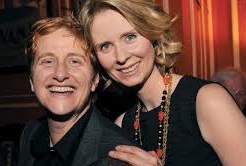

"Falling in love with my wife was one of the great
delights and surprises of my life, but it didn’t seem
like I became a whole new person, or like some door had
been unlocked,” she said. "It was like: ‘I have fallen
in love with different people in my life and they’ve all
been men before. Now this is a woman and she is
amazing.’”
With Tony and Emmy awards to her name, Nixon has also
always been an ardent activist for various causes
including LGBTQ rights and the environment. In 2018, she
ran against Andrew Cuomo in the New York gubernatorial
race. At this juncture, Nixon, whose son Samuel is
transgender, has called for LGBTQ people to stick
together in the face of opposition from conservatives.
"It’s a really peculiar thing, how much the right wing
try to separate us as a community,” she said.
"But after
same-sex marriage was legalized we saw a great divide in
our own community too, between those who thought, I got
my wedding ring, I can pass my money on to my spouse and
not pay taxes, so I’m good, I’m done, as opposed to We
have so far to go for so many members of our community,
we are still so far from the promised land, we’re so far
from having our full civil rights."
In 2012,
Nixon, who had identified as bisexual, went on the
record and confirmed that bisexuality is not a choice
after taking a lot of heat for saying it was her choice
to be in a “gay” relationship with Marinoni. She
previously stated: "My recent comments in The New York
Times were about me and my personal story of being gay.
I believe we all have different ways we came to the gay
community and we can't and shouldn't be pigeon-holed
into one cultural narrative which can be uninclusive and
disempowering.
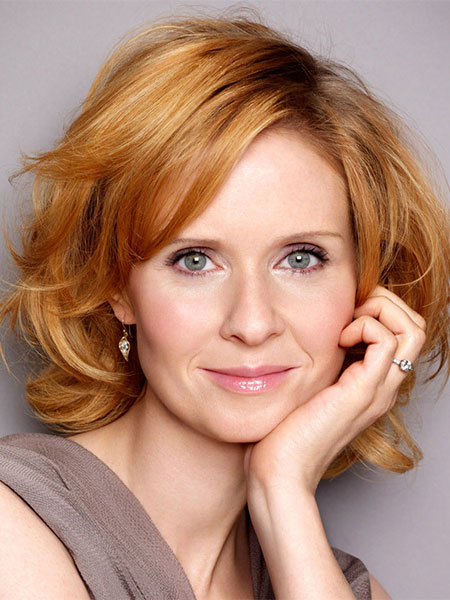

However,
to the extent that anyone wishes to interpret my words
in a strictly legal context I would like to clarify:
"While I don't often use the word, the technically
precise term for my orientation is bisexual. I believe
bisexuality is not a choice, it is a fact. What I have
'chosen' is to be in a gay relationship.
"As I said in the Times and will say again here, I do,
however, believe that most members of our community (as
well as the majority of heterosexuals) cannot and do not
choose the gender of the persons with whom they seek to
have intimate relationships because, unlike me, they are
only attracted to one sex. Our community is not a
monolith, thank goodness, any more than America itself
is. I look forward to and will continue to work toward
the day when America recognizes all of us as full and
equal citizens."
[Source:
Tracy E. Gilchrist, Advocate Magazine, September 2020]
Why Being a Lesbian is Amazing
Lesbians Have More Orgasms Than Straight Women
Lesbian Creators We're Obsessed With
Info: Women and Feminism
Butches and Studs
Hottest Lesbians Streaming on TV Right
Now
Best Lesbian Vampire Movies
Drew Barrymore Flirts with Taylor Tomlinson
Giving Up My Love of Long Nails?
You Tube: Notable Lesbians
Juliana and Valentina: Say it Again
Lesbian Dating Tips: How Can You Tell If a Girl Likes
You
WLW: Making Us Believe in Love Again... Sapphic Love is
Alive and Well
Best Lesbian Movies Ever Made
1965 Report: Female Homosexuality
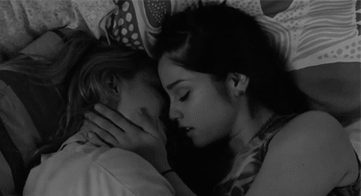
Nick and Benedetta
Curve: Five Types of Lesbians
Jess and Emily: How Lesbians Do It
Say I Love You
Sultriest Lesbian and Sapphic Femmes in TV and Film History
It’s Never Too Late to Become a Lesbian
Lesbian Dating 101
Gal Pals and Compulsory
Heterosexuality
Mia and Pauline
Lesbian Love Languages
Curve: Lesbian
Magazine
Epic Journey to America's Last Lesbian Bars
Mental Health Issues Lesbian Women Cope With
Info: Sexual Orientation
Mermaid Tavern
More Than
Sexuality
The labels
and language of affection
Do you
have an "affectional preference" for female
companionship? Hey, world, big news! Gay people are
more than our sexuality. It can be downright annoying to
be defined by one part of our humanity.
I may live in rural America, but I am not a walking,
talking letter “Q” for queer. Not an advertisement for a
lifestyle. Not a representation of what-dykes-look-like.
Not an object of study or fascination. Not a target of
foul words, flung mud, or physical violence.
I am a lover of women, but that encompasses a heck of a
lot more than sexual expression. When I was younger even
I didn’t know that was true. I didn’t know I could love
a woman friend without intimate touch. I believed the
homo-hating hype that coming out made me
one-dimensional.
Today, we can see photos of people like us who are
unencumbered by stereotypes. We watch gay people become
champion athletes, TV and film and theater stars, heads
of corporations, politicians. I like to think all our
efforts have helped to provide solid groundwork for gay
lives to be fulfilling.


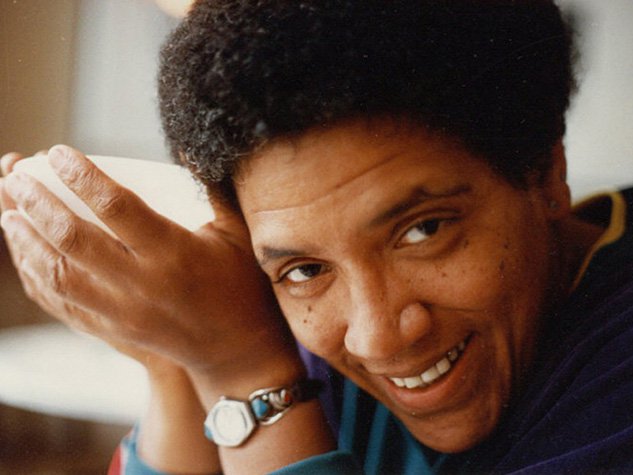
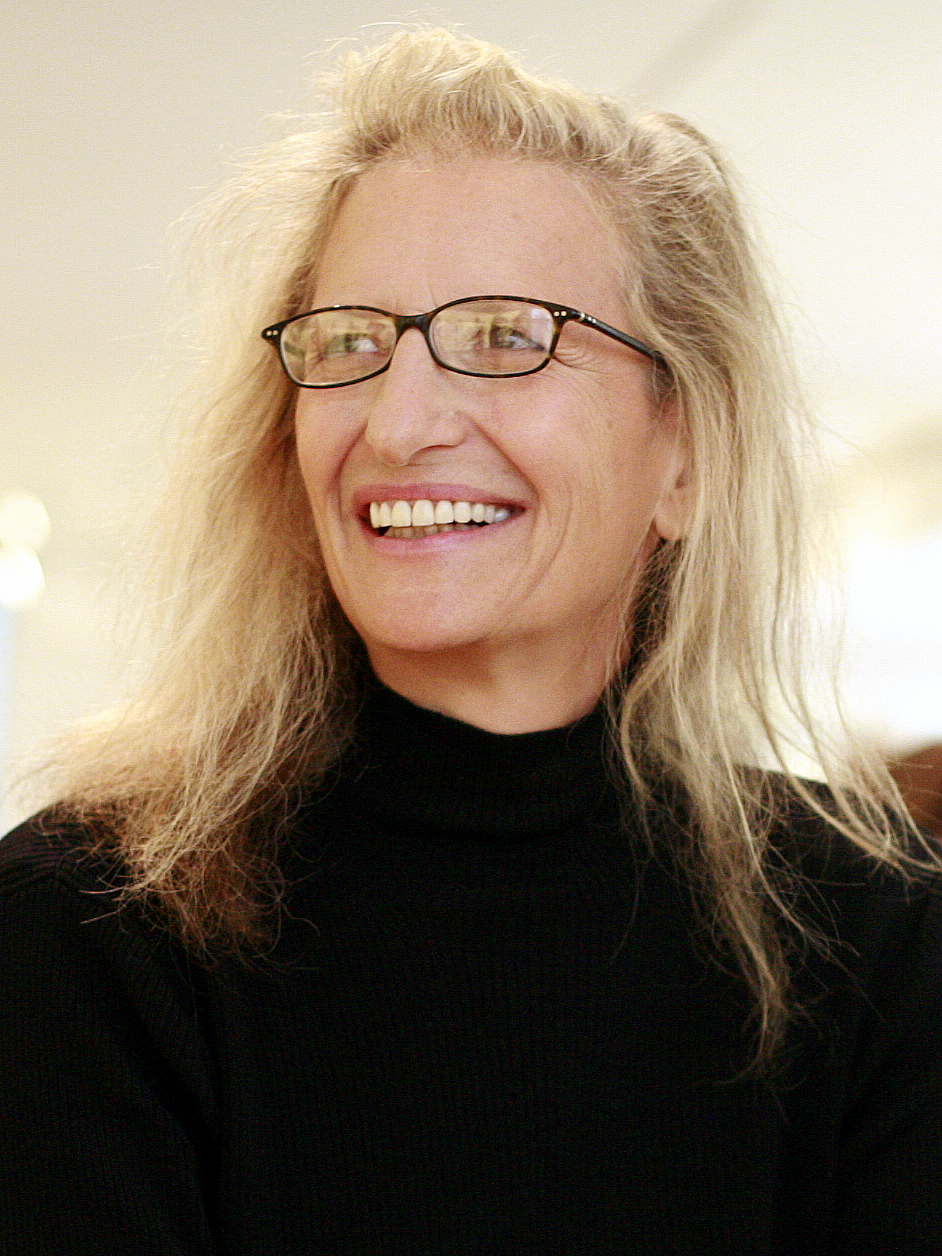
Am I Really Proud to Be a Lesbian?
Advocate Magazine: Women of the Year
Renee Rapp Presents Award for Power in
Lesbianism
Info: Skirt Club
Wikipedia: Definition of Lesbian
Honey by Kehlani
Ten Things Lesbians Hate to Hear
Info: Sexual Orientation
Queer Women with Tantalizingly Sexy Hands
Lesbians in the 1980s
It is time to look at how language continues to be one
of our stumbling blocks. Change is already happening.
Little by little a majority of Americans are becoming
respectful of gay people, are realizing they need not
focus conversation on gay matters. They are finding out
that we are not threats and that we have more in common
with them than not.
Both gays and non-gays need new language for the concept
that we are the family next door, the gal who pumps gas,
the transgender head of the corporation. We need to move
beyond words that mark us in a solely sexual way.
I’ve been using the phrase affectional preference. While
I enjoy the company of some men, mostly gay men, my
closest friends and family are women. If I’m going out
somewhere, I go with women. If I join an organization,
it’s more likely to be woman-centered than co-ed. If I
exercise or swim, I like to do so in the company of
women. I do business with women, preferably gay. There
is no sexual component in any of those activities. Why
am I the only one with a sexual label in a room full of
non-gay women who’ve gathered for lunch? I have
affection for these women, not attraction to them.
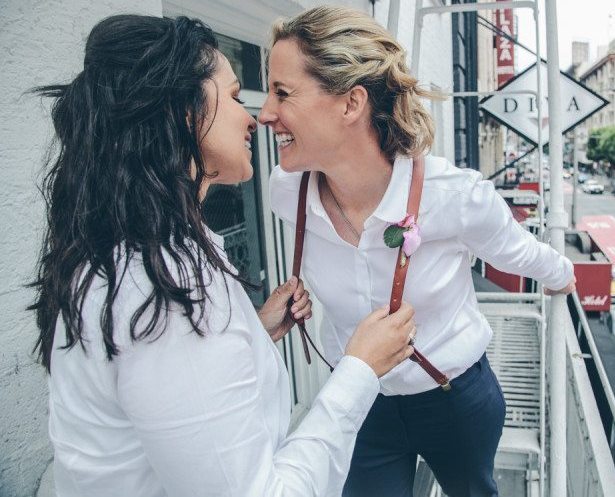



In my marriage, of course there is the kind of intimacy
that would scare straight boys. But, we just might be
sitting in our living room discussing our day and
reading. Or cooking dinner and doing the dishes. We
might even be doing the laundry, cleaning the toilets,
filling the bird feeders. So call us bird lovers, cooks,
readers. Our passion for birds and books have nothing to
do with sexual preferences. We simply like to share
everyday life together as two loving women.
Let’s stop sexualizing ourselves and come up with words
that reflect the greater percentage of our days and
ourselves—if we have to be labeled at all. Please note,
it’s not the sex itself I want to eliminate, it’s the
restrictive branding.
[Source: Lee Lynch, Writer, Epochalips]
I Think I Might Be a Lesbian
Lesbian Coming Out at 40
Miriam Margolyes Identifies as an
Unapologetically Woke Left-Wing Dyke
Noora, Are You a Lesbian?
Mermaid Tavern
Queer YouTubers: Losing Your Virginity
No
More Blues by FreenBecky
Awesome Things About Lesbian Relationships
Paige and Holly: Hugs and Cuddles
Belly Kisses by Rachel Wiley
Gal Pals and Compulsory
Heterosexuality
Lesbian Literature
Sultriest Lesbian and Sapphic Femmes in
TV and Film History
Breanne Williamson: I Am a Lesbian
Mia & Pauline
LeSbo
NainA: Pure Leabian Page
Best Lesbian Vampire Movies




Wise Lesbian
Quotes
"I will
not have my life narrowed down. I will not bow down to
somebody else's whim or to someone else's ignorance."
-Alice Walker, Writer
“I am a strong, black, lesbian woman. Every single time
I say it, I feel so much better.”
-Brittany Griner, Athlete
“A woman and a woman together are beautiful, just as a
man and a woman together are beautiful.”
-Drew Barrymore, Actor
“What I preach is: People fall in love with people, not
gender, not looks, not whatever. What I’m in love with
exists on almost a spiritual level.”
-Miley Cyrus, Singer




Sam & Mon: Love Me Like You Do
How The L Word Changed Lesbian Television
Romantic Films All Queer Women Need to Watch
Jezebel: Girl's Guide to Lesbian Clichés and Stereotypes
Lesbians in the 1980s
“I want to make sure that any young person or anyone
really who is looking up to me—who sees a glimpse of I
am as a person—that they see no shame, that they see
pride, and that I’m truly unabashed about the person
that I am.”
-Samira Wiley, Actor
“Being born gay, black and female is not a revolutionary
act. Being proud to be a gay, black female is.”
-Lena Waithe, Film Producer
"I write for those women who do not speak, for those who
do not have a voice because they were so terrified,
because we are taught to respect fear more than
ourselves. We've been taught that silence would save us,
but it won't."
-Audre Lorde, Writer
"Find out who you are and be that person. That's what
your soul was put on this Earth to be. Find that truth,
live that truth and everything else will come."
-Ellen DeGeneres, Entertainer
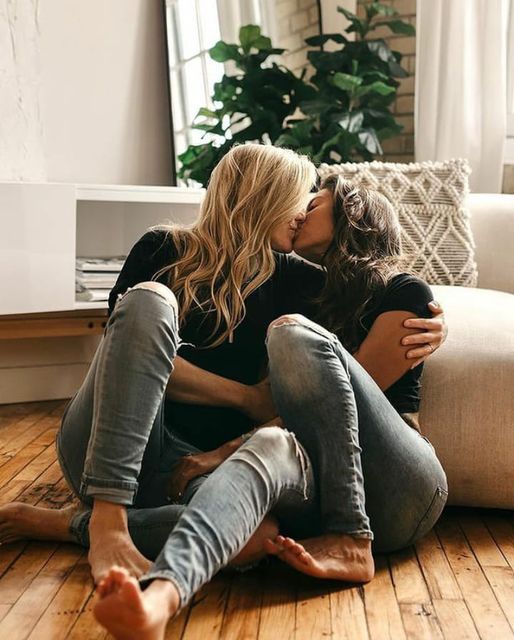


Honey by Kehlani
Ten Things Lesbians Hate to Hear
Ally and Sam
1965 Report: Female Homosexuality
Lesbians in the 1980s
Paige and Holly: Smash or Pass
Queer Girls Googling
Best Lesbian Movies Ever Made
Queer Women Who Changed History
Petra and Jane: I Love You
Hello It's Me
Queer Women with Tantalizingly Sexy Hands
Lesbian Creators We're Obsessed With
Sultriest Lesbian and Sapphic Femmes in
TV and Film History
"Being optimistic is like a muscle that gets stronger
with use. Makes it easier when the tough times arrive.
You have to change the way you think in order to change
the way you feel."
-Robin Roberts, Television Host
"If you feel like there's something out there that
you're supposed to be doing, if you have a passion for
it, then stop wishing and just do it."
-Wanda Sykes, Comedian
"There's girls that grew up like me and even worse, and
they need to know that there is someone out there that
can give them hope. It's about inspiring people and
helping people."
-Kehlani, Musician
"You really need to trust that you're on your own path,
and as long as you stay true to it, and you show up, you
will be successful."
-Jane Lynch, Actor
Inspiring Quotes For Queer Women To Live By
Karine Jean-Pierre Hosts L Word Cast
at White House Press Briefing
Lesbian Highlights of 2022
Cynthia Nixon: Why She
Identifies as Queer
Game-Changing Queer Women to Celebrate
Women's History Month
Commentary: Why I Am
Nobody's Wife
XtraMagazine: No, Lesbians
Are Not Disappearing
Am I Really Proud to Be a Lesbian?
Advocate Magazine: Women of the Year
100 Lesbian Things To Do Before You Die
Ruthie Berman: Pioneering Lesbian Shares
Her Epic Love Story
What Is a Lesbian Boyfriend? How Sapphic Relationships
Play With Gender

Lesbians Holding
Hands in Public
In 1977
two women were convicted of "obscene behavior" for
holding hands on a tram in Melbourne, Australia.
Their story was even the focal point of the Victorian
Government’s apology to gays and lesbians convicted of
overturned homosexuality laws.
40 years after the lesbians’ arrest, a group of women
honored them in Melbourne with an event called "Hold
Hands on a Tram," during which they gathered as a
demonstration and publicly held hands with each other.
"This event was amazing," said organizer and director of
Celebrate Ageing, Catherine Barrett. "We had 20 lesbian
elders board the tram and a group of LGBTQ community
members come to send us off. We also had a number of
straight folk who heard about the project and wanted to
come along to show their support. This was all very
moving and bought a number of us to tears."
But even in 2017 some of the women were still nervous
about holding hands in public. Barrett told Gay Star
News it was sign that society still has a long way to
go. "A number of women told me that they were really
nervous. They don’t generally hold hands in public, it
has not been safe to do so," she said. "So even though
we were travelling in a group they were frightened of
the responses from the general public."
Lesbophobia is real. "Hold Hands on a Tram" was
organized to remind people of lesbopobia, the
discrimination uniquely faced by lesbians. It was also a
chance to highlight some of the struggles older lesbians
face.
[Source: Shannon Power, GSN, Melbourne, Australia, Oct
2017]
Music Video: I Need a Woman to Love
History of Lesbian Fashion
Lesbian Love Songs: Women Singing About Women
Info: Women and Feminism
List: US Lesbian Periodicals
Breanne Williamson: Why I Hate the Word Lesbian
Paige and Holly: Smash or Pass
Why Being a Lesbian is Amazing
Short Film: To My Future Girlfriend
List: Worldwide Lesbian Periodicals
Sultriest Lesbian and Sapphic Femmes in
TV and Film History
Great Big Lesbian Dictionary
Video Montage: Best Lesbian Kisses
Lesbian Creators We're Obsessed With




Lesbians
in Love

Science:
Evolution and Lesbians
Straight
women are much more likely to get themselves knocked up
than gay women. So, in terms of evolution, they would
seem to have a better chance of passing on their genes,
while at the same time it would seem that the genes that
make women gay would quickly vanish from the gene pool.
This raises the question, why are there gay women?
Lesbianism is indeed at least 25 percent genetic, as
determined by a 2011 study of twins conducted in the
United Kingdom. The study found that identical twin
sisters (who share 100 percent of their DNA) are more
likely to both be lesbians than are fraternal twin
sisters (who share just 50 percent), proving that, all
other environmental factors being equal, genes matter.
While scientists have a theory for how male
homosexuality propagates from one generation to the
next, no one has yet produced a viable explanation for
how the genes that promote lesbianism might do the same.
A female's sexual orientation also appears to be partly
influenced by her level of exposure to the male sex
hormone androgen when she is in the womb. Greater
hormone exposure correlates with more gender
nonconformity early in her life (as a child, she may be
called a "tomboy"), as well as a same-sex orientation
later on. A study by Dutch psychologists published in
the March issue of the Journal of Sexual Medicine
reported that 10 to 12 percent of male and female
children who feel discomfort with their gender go on to
identify as gay or lesbian as adults. Meanwhile, just 1
or 2 percent of children who are comfortable with their
gender identity turn out to be gay or lesbian.




Lesbians Have More Orgasms Than Straight Women
New Research: Lesbians More Accepted Than Gay Men
Best Lesbian Vampire Movies
Epic Journey to America's Last Lesbian Bars
Paige and Holly: Our First Time
Music Video: I Wish You Were Gay
Cathy's Coming Out Story
Lesbian Creators We're Obsessed With
Sorry Straights, These Karaoke Songs
Belong to the Lesbians
Candid Answers to Questions About Lesbian Sex
Tribute to the Women Who
Spoke Up for Lesbian Rights
Info: Skirt Club
Video List: Most Famous Lesbians in History
Breanne Williamson: I Am a Lesbian
Queer Women Who Changed History
Queer
Adding to the confusion about what causes lesbianism is
the slipperiness of female sexuality itself. Unlike men,
who are usually sexually oriented solely toward men or
women, and whose sexuality is essentially fixed from
puberty on, a decade of research by the University of
Utah psychologist Lisa Diamond and others demonstrates
that women have greater "erotic plasticity." Their
sexual orientation can be shaped by cultural influences,
altered by positive or negative experiences and
intensified by feelings of love or attachment. Women are
far more likely than men to "report remarkably late and
abrupt onset of same-sex sexuality, often after
heterosexual marriage," Diamond wrote in January in the
Archives of Sexual Behavior.
Their sexual fluidity may emerge from the fact that,
across the board, women are sexually aroused by images
of both men and women (while men are typically only
aroused by members of their preferred sex).
Therefore, the question "why are there gay women?" may
be better worded as "why is female sexuality so fluid?"
Plenty of women exist at both extremes of the
straight-gay spectrum, but it is the formation of this
slippery spectrum itself that most needs explaining.
Evolutionary biologists have yet to determine what
survival or reproductive benefit women's "erotic
plasticity" confers.
[Source: Natalie Wolchover, Life's Little Mysteries,
June 2012]
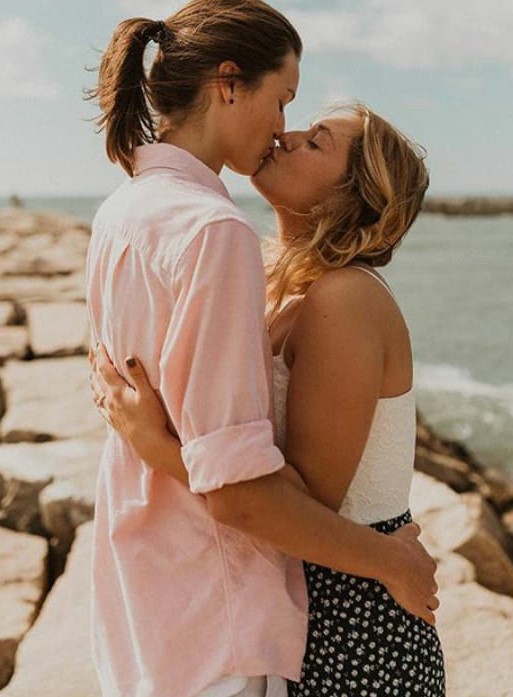


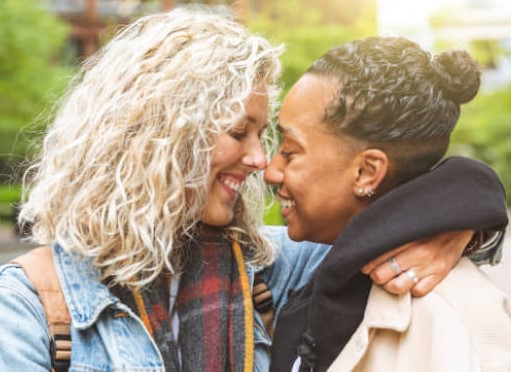
Am I Really Proud to Be a Lesbian?
Advocate Magazine: Women of the Year
Wikipedia: Definition of Lesbian
Honey by Kehlani
Paige and Holly: Smash or Pass
Ten Things Lesbians Hate to Hear
Women Who Changed the Course of LGBTQ History
Info: Sexual Orientation
Belly Kisses by Rachel Wiley
Queer Women Who Changed History
You Tube: Notable Lesbians
Info: LGBTQ Community
What Is a Lesbian Boyfriend? How Sapphic Relationships
Play With Gender
Dating a
Woman For The First Time: Here's What's Different
Personally, two years into my first-ever lesbian
relationship, I'm very happy to take the time to
acknowledge the amazing lesbians out there in the world
— my girlfriend included. And, as someone who has had
sex with women but only dated men before this
relationship, I appreciate being in a lesbian
relationship all the more.
Firstly, I'm a bisexual and proud of it. And being in a
lesbian relationship in no way takes away from the fact
that I am a bisexual — there is no acceptance of bi
erasure here. Still bi. Still here. Still proud. But
what being in a lesbian relationship has done is made me
realize how effing amazing being in a lesbian
relationship is. Because there are a lot of differences
between dating a man and dating a woman and most of them
make me so freaking grateful that the person I fell for
is a fellow femme.


Girls Just Being Hella Gay
Tribute to the Women Who
Spoke Up for Lesbian Rights
Honey by Kehlani
Lesbians in the 1980s
Best Lesbian Movies Ever Made
Hello It's Me
Jess and Emily: How Lesbians Do It
Curve: Lesbian
Magazine
Sam & Mon: Romantic Scenes
Epochalips: Smart
Lesbian Commentary
Dyke vs Lesbian
Cosmo: Lesbians Reveal Exact Moment They Fell in Love
Video Discussion: My First Relationship With a Woman
Lesbian Love Languages
So if you've ever thought about acting out your sapphic
leanings and switching your Tinder search to women, here
are some factors worth considering.
I hate the check dance on dates. The idea that I
shouldn't pay is a patronizing throwback to when women
were, you know, basically property. I don't care that
it's tradition, I find it really uncomfortable and a
little insulting when someone acts like I shouldn't pay.
With a woman, it's not awkward at all (or at least, just
the normal amount of money awkwardness).
If you've ever had to congratulate a guy for not being a
misogynistic asshole, you'll know what I'm talking
about. I was sick of praising someone for being a
feminist or it feeling like a deliberate choice when my
needs were valued as much as they were.
In a hetero relationship, you're always encountering
gender norms — whether adhering to or ignoring them.
With two women, you just get to sidestep them
completely.
OK, it's not all good. There will be blood. A lot of
blood. But luckily no squeamishness around it — and
there's almost always a spare tampon laying around.
Seriously. Our apartment is 90-per-cent tampons.
Like I said, some things are harder with women. I was
actually way more self-conscious dating women than
dating men. Even though I think of men as being more
judgmental, feeling like there is a more direct
comparison between you and your partner was tough at
first. But once I got over it, I've never felt more
confident than when I've been dating a woman.



THIS. This is the best thing ever. There's no
micromanaging a man's feelings. There's no stress of
being the only person who notices that you need to buy
toilet paper or that you need to buy a birthday gift. No
praising someone because they did a single effing dish
after dinner. There's no silent resentment brewing over
housework or errands, because we both come at things
from the same place — the burden is genuinely split,
rather than having to tell someone what to do and
feeling like a nag.
I know, I know. I'm making a major generalization here
based on my personal experience with a handful of men
and my current experience with one awesome-ass lady. If
you've got yourself a man who puts in that mental labor,
you're killing it. Have him tell his friends. Encourage
him to lead a seminar.
[Source: Bellesa, HuffPost, Nov 2017]
Queer Women Who Changed History
Am I Really Proud to Be a Lesbian?
Advocate Magazine: Women of the Year
Wikipedia: Definition of Lesbian
Honey by Kehlani
Ten Things Lesbians Hate to Hear
Info: Sexual Orientation
Queer Women with Tantalizingly Sexy Hands
No
More Blues by FreenBecky
You Tube: Notable Lesbians
Info: LGBTQ Community
Cheryl Clark:
Not Straight, But Crooked
In 1982,
Black Lesbian Feminist Poet and Scholar Cheryl Clarke
wrote a letter to her fellow Black Feminist Poet June
Jordan: “No, there is nothing wrong with your eyes,” she
reassured her colleague and collaborator, “my letterhead
is indeed crooked.” June Jordan saved the letter and I
found it almost three decades later in Jordan’s papers
at the Schlessinger Archive at Harvard University.
Crooked, indeed. Cheryl Clarke’s life and work offer an
enduring rejection of straightness and a constant
reorientation to alternative space.
Cleryl
Clark was a poet and scholar of the Black Arts Movement
and activist who attended Black Feminist Retreats from
1977 to 1980. She was editor at Conditions (a key
lesbian feminist literary journal) for many years, a
Rutgers University administrator providing safe space
for LGBTQ students, a member of the Newark Pride
Alliance board since 2009, and most recently co-owner of
an independent bookstore.



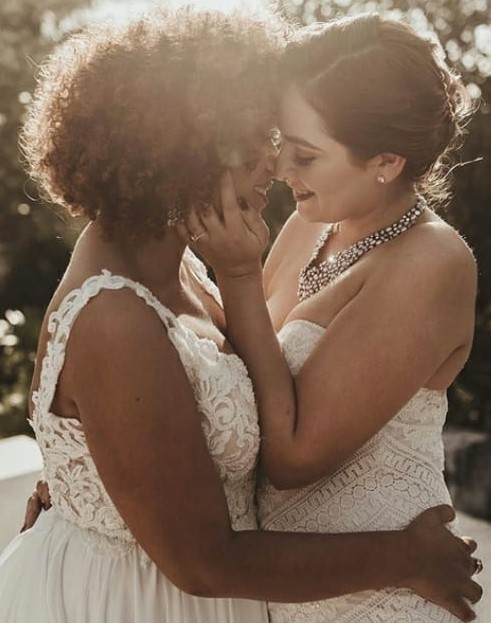
New Research: Lesbians More Accepted Than Gay Men
Mia & Pauline
Music Video: I Wish You Were Gay
Cathy's Coming Out Story
Candid Answers to Questions About Lesbian Sex
Tribute to the Women Who
Spoke Up for Lesbian Rights
Video List: Most Famous Lesbians in History
Breanne Williamson: I Am a Lesbian
LeSbo
NainA: Pure Leabian Page
Belly Kisses by Rachel Wiley
Queer Girls Googling
What Is a Lesbian Boyfriend? How Sapphic Relationships
Play With Gender
In the crooked letter, Cheryl Clarke critically asks
June Jordan why she does not identify as a lesbian, an
identity marker Clarke claimed proudly and, in fact,
redefined. In an essay she wrote the next year she
explained:
“I name myself lesbian because this culture
oppresses, silences, and destroys lesbians, even
lesbians who do don’t call themselves lesbian. I
name myself lesbian because I want to be visible
to other black lesbians. I name myself lesbian
because I do not subscribe to
predatory/institutionalized heterosexuality. I name
myself lesbian because I want to be with women
(and they don’t all have to call themselves lesbian).
I name myself lesbian because it is part of my
vision. I name myself lesbian because being
woman-identified has kept me sane. I call myself
Black, too, because Black is my perspective, my
aesthetic, my politics, my vision, my sanity.”
You can read “New Notes on Lesbianism” and other works
in The Days of Good Looks: The Prose and Poetry of
Cheryl Clarke, 1980 to 2005.


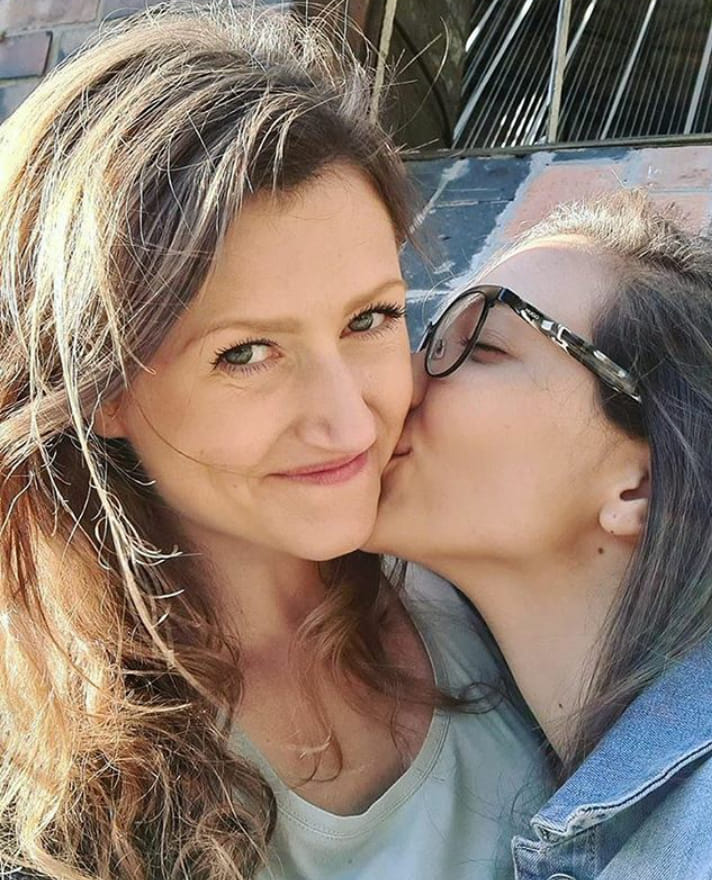

Wikipedia: Definition of Lesbian
Dyke vs Lesbian
Lesbians in the 1980s
Sam & Mon: Call Out My Name
Ten Things Lesbians Hate to Hear
Franky and Bridget: Love Me Like You Do
Best Lesbian Vampire Movies
Essential Lesbian Guide to Flirting
Why Being a Lesbian is Amazing
Hello It's Me
As a queer
black identified woman, Cheryl Clarke is one of the
reasons why I feel nothing but pride when people call me
a lesbian. She gives audacious, specific, and loving
definition to a term that would merely conjure up images
of herbal tea and cats. And Cheryl has not gotten less
audacious or inventive in the decades that have passed
since the 70’s and 80’s. In fact, more recently in a
2005 response to the mostly white male-led marriage
equality agenda, she controversially reminded our
movement of its history saying:
“I am calling upon bulldaggers, dykes, faggots, feminist
femmes, fierce sissies, and other outrageous progressive
queers to have a major multicultural sexual liberation
confabulation to take our movement back from liberals.
Because marriage equality with its rhetoric of sameness
is not why we came out of the closet in 1969 or before.
We came out to dismantle marriage as an institution.”
In October 2013, I attended a historic gathering called
"Cheryl Clarke: A Future Retrospective." At that event,
we reminded ourselves where we came from and the
boldness with which we must move forward as activists,
editors, artists, bookstore owners, scholars,
performers, mentors, publishers, bulldaggers, dykes,
faggots, feminist femmes, fierce sissies, outrageous
progressive queers, and everyone else who can boldly
honor this visionary in our movement and remind
ourselves and each other what a lifetime of badass
brilliance feels like!
[Source: Alexis Pauline Gumbs, Feminist Wire, Oct 2013]

Endless Love:
Audrey and Camille
Paige and Holly: How We Became Girlfriends
Incredible Lesbians Who are Loud, Proud
and Making the World a Better Place
Queer Women Who Changed History
Lesbian Couples: Somewhere Only We Know
Music Video: Love on Fire
Mermaid Tavern
Noora, Are You a Lesbian?
Ellia and Cassie
Video Discussion: My First Relationship With a Woman
Tribute to
Sappho
“Sweet
mother, I cannot weave. Aphrodite has overcome me with longing for a girl.”
The word "lesbian" is derived from the
name of the Greek island of Lesbos, home to the 6th
Century poet Sappho (Circa 630 BCE - 570 BCE). From various
ancient writings, historians have gathered that a group
of young women were left in Sappho's charge for their
instruction or cultural edification. Not much of
Sappho's poetry remains, but that which does reflects
the topics she wrote about: women's daily lives, their
relationships, and rituals. She focused on the beauty of
women and proclaimed her love for girls. Before the late
19th Century, the word "lesbian" referred to any
derivative or aspect of Lesbos, including a type of
wine.
Sappho is the most famous female poet of antiquity, but
only incomplete poems and fragments remain of her work.
Most of Sappho's lyrical love poems were addressed to
women. She was sometimes considered the female
counterpart of Homer. The Greek philosopher Plato called her the
Tenth
Muse.

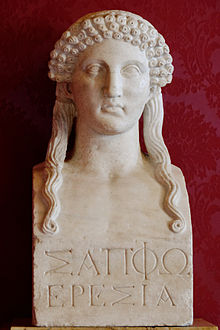
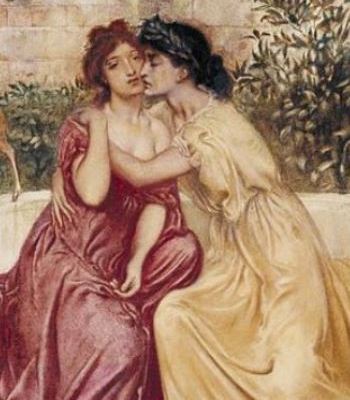
Sappho:
Poems and Quotations
Poetry Foundation: Sappho
New Yorker: Who Was Sappho?
Ancient History Encyclopedia: Sappho of Lesbos
Origin of the Word Lesbian
Wikipedia: Sappho
Facts about Sappho's life are scant. She was an
aristocrat, who wrote poetry for her circle of friends,
mostly but not exclusively women. She may have had a
daughter. The term lesbian, her presumed sexual
orientation, is derived from the name of her island
home, Lesbos. The ancients had seven or nine books of
her poetry. Only fragments survive. The longest is an
invocation to Aphrodite asking her to help the poet in
her relation with a beloved woman. Her verse is a
classic example of the love lyric, and is characterized
by her passionate love of women, a love of nature, a
direct simplicity, and perfect control of meter.
In 1890, the term "Sapphism" was used in a medical dictionary as an
adjective to describe tribadism and
as the sexual gratification of two women by simulating
intercourse. "Sapphism" was used for a long time, in a
positive way, to mean "lesbian love." The use of
the term "lesbianism," to describe erotic
relationships between women, had been documented in 1870.
The terms "lesbian" and "lesbianism" were interchangeable with "Sapphist" and "Sapphism"
around the turn of the 20th Century. The use of
"lesbian" in medical literature became prominent.
By 1925, the word was recorded as a noun to mean the
female equivalent of a sodomite.
I Think I Might Be a Lesbian
She Likes Girls
Lesbian Coming Out at 40
Romantic Films All Queer Women Need to Watch
Paige and Holly: I Wanna Marry You
Belly Kisses by Rachel Wiley
Lesbian Tunes: New Sapphic Pride Anthems
Noora, Are You a Lesbian?
Mermaid Tavern
100 Lesbian Things To Do Before You Die
Queer YouTubers: Losing Your Virginity
Awesome Things About Lesbian Relationships
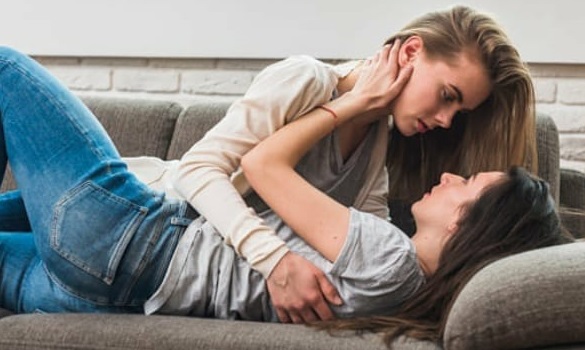
Health Issues
for Lesbians and Women Who Have Sex with Women
All women
face certain health risks. However, sexual minority
women, such as those who identify as lesbian or bisexual
as well as women who have sex with women, have some
specific health concerns. Although your individual risks
are shaped by many factors beyond your sexual
orientation and practices (including family history and
age) it's important to understand common health issues
for sexual minority women and steps you can take to stay
healthy.
Safeguard your mental health
Sexual
minority women are at higher risk of depression and
anxiety. Contributing factors include social alienation,
discrimination, rejection by loved ones, abuse and
violence. The problem might be more severe for sexual
minority women who are not "out" to others and those who
lack social support. If you think you might be
depressed, talk to your doctor or seek help from a
mental health provider. If you're reluctant to seek
treatment, confide in a trusted friend or loved one.
Sharing your feelings might be the first step toward
getting treatment.


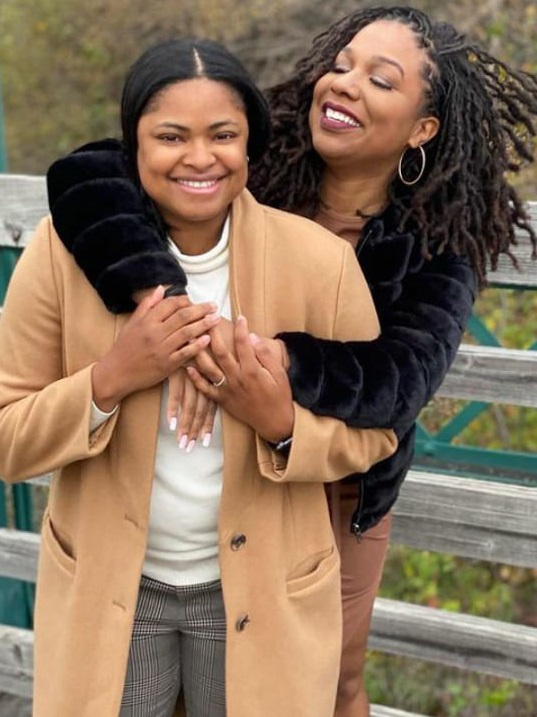
Breanne Williamson: I Am a Lesbian
Butches and Studs
Tribute to the Women Who
Spoke Up for Lesbian Rights
Honey by Kehlani
Lesbians in the 1980s
Jess and Emily: How Lesbians Do It
Hello It's Me
Best Lesbian Movies Ever Made
LeSbo
NainA: Pure Leabian Page
Epochalips: Smart
Lesbian Commentary
Dyke vs Lesbian
No
More Blues by FreenBecky
What Is a Lesbian Boyfriend? How Sapphic Relationships
Play With Gender
Protect yourself from sexually transmitted infections
Certain sexually transmitted infections (human
papillomavirus (HPV), bacterial vaginosis,
trichomoniasis) can spread between women. Oral sex and
sexual behavior involving digital-vaginal or
digital-anal contact, particularly with shared
penetrative sex toys, can spread infections as well.
Female sexual contact is also a possible means of
contracting HIV, the virus that causes AIDS. There's no
cure for HIV/AIDS and many sexually transmitted
infections, such as HPV and genital herpes. The best way
to stay healthy is to practice safer sex.
To protect yourself from sexually transmitted
infections:
--Get tested and have your partner tested. Don't have
unprotected sex unless you're certain you and your
partner aren't infected with HIV or other sexually
transmitted infections — whether you have sex with a man
or a woman. Testing is important because many people
don't know they're infected, and others might not be
honest about their health.
--Practice
safer sex. During oral sex, use a small piece of latex
(dental dam) or latex barrier. Wash sex toys with hot
soapy water between uses or cover them with a fresh
condom. During digital vaginal or anal penetration,
consider using a latex glove.
--Be
monogamous. Another reliable way to avoid sexually
transmitted infections is to stay in a long-term
mutually monogamous relationship with a partner who
isn't infected.
--Limit
the amount of alcohol you drink, and don't use drugs. If
you're under the influence, you're more likely to take
sexual risks. If you choose to use injectable drugs,
don't share needles.
--Get
vaccinated. Vaccinations can protect you from hepatitis
A and hepatitis B, serious liver infections that can
spread through sexual contact. The HPV vaccine is
available to women up to age 26.

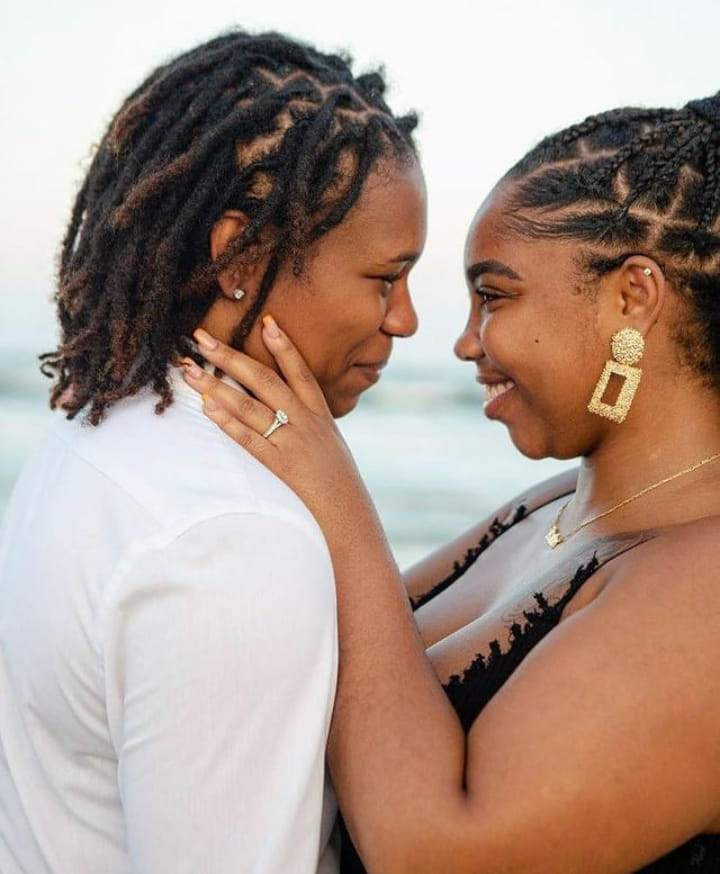

My First Date With a Girl
No
More Blues by FreenBecky
Jess and Emily: How Lesbians Do It
Hello It's Me
Lesbian Insights: Sexual Activity in 1966
You Tube: Notable Lesbians
She Likes Girls: Breathing Underwater
I Want You: Love is Love
Queer Women Who Changed History
Info: Women and Feminism
Am I a Lesbian? (Masterdoc)
Paige and Holly: I Wanna Marry You
Seek help for substance abuse
Sexual minority women report higher rates of tobacco use
and alcohol and drug dependence. If you have a substance
abuse concern, remember that help is available. Local
lesbian, gay, bisexual and transgender health, mental
health or community centers often provide substance
abuse treatment. Organizations such as GLMA also might
provide referrals.
Recognize domestic violence
Domestic
violence can affect anyone in an intimate relationship.
Sexual minority women might be more likely to stay
silent about this kind of violence due to threats from
the batterer to "out" you by telling friends, loved
ones, colleagues or community members your sexual
orientation. A fear of discrimination. Staying in an
abusive relationship might leave you depressed, anxious
and hopeless. If you don't want to disclose your
same-sex relationship or sexual identity, you might be
less likely to seek help after an assault. Still, the
only way to break the cycle of domestic violence is to
take action — the sooner the better. If you're a target
of domestic violence, tell someone about the abuse,
whether it's a friend, loved one, health care provider
or other close contact. Consider calling a domestic
violence hotline and creating a plan to leave your
abuser.

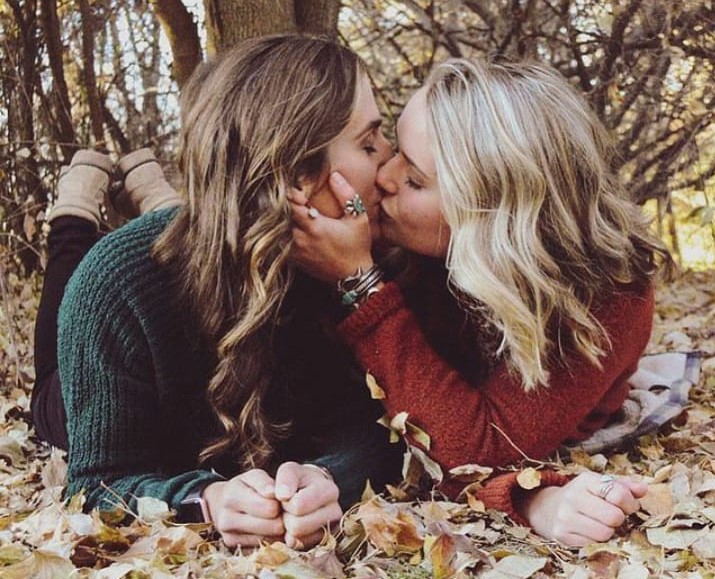
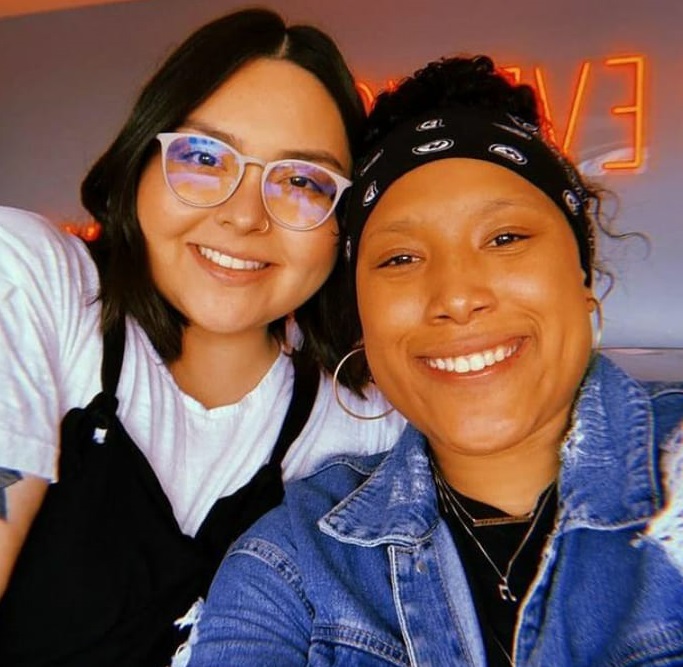
Make routine health care a priority
Some sexual minority women struggle to find a doctor
knowledgeable about their specific health issues and
with whom they feel comfortable discussing their needs
and concerns. Look for a doctor who is curious, empathic
and respectful of your specific needs. Share your sexual
orientation with your provider, and ask about routine
screenings recommended for women in your age group —
such as blood pressure and cholesterol measurements and
screenings for breast cancer and cervical cancer. If
you're not in a long-term, mutually monogamous
relationship, schedule regular screenings for sexually
transmitted infections. Share any other health concerns
you might have with your doctor as well. Early diagnosis
and treatment help promote long-term health.
[Source: Mayo clinic]
Lesbian Highlights of 2022
Cynthia Nixon: Why She
Identifies as Queer
Game-Changing Queer Women to Celebrate
Women's History Month
Commentary: Why I Am
Nobody's Wife
XtraMagazine: No, Lesbians
Are Not Disappearing
Am I Really Proud to Be a Lesbian?
Advocate Magazine: Women of the Year
Butches and Studs
Incredible Lesbians Who are Loud, Proud
and Making the World a Better Place
100 Lesbian Things To Do Before You Die
Ruthie Berman: Pioneering Lesbian Shares
Her Epic Love Story
What Is a Lesbian Boyfriend? How Sapphic Relationships
Play With Gender
Why It's Never
Too Late to be a Lesbian
For Carren Strock, the revelation came when she was 44.
She had met her husband – "a terrific guy, very sweet" –
at high school when she was 16, had been married to him
for 25 years, had two dearly loved children, and what
she describes as a "white-picket-fence existence" in New
York. Then, one day, sitting opposite her best friend,
she realized: "Oh my God. I'm in love with this woman."
The notion that she might be a lesbian had never
occurred to her before. "If you'd asked me the previous
year," she says, "I would have replied: 'I know exactly
who and what I am – I am not a lesbian, nor could I ever
be one.'"
From that moment Strock's understanding of her sexuality
changed completely. She felt compelled to tell her
friend, but her attraction wasn't reciprocated; at first
she wasn't sure whether she had feelings for women in
general, or just this one in particular. But she
gradually came to realize, and accept, that she was a
lesbian. She also started to realize that her experience
wasn't unusual.
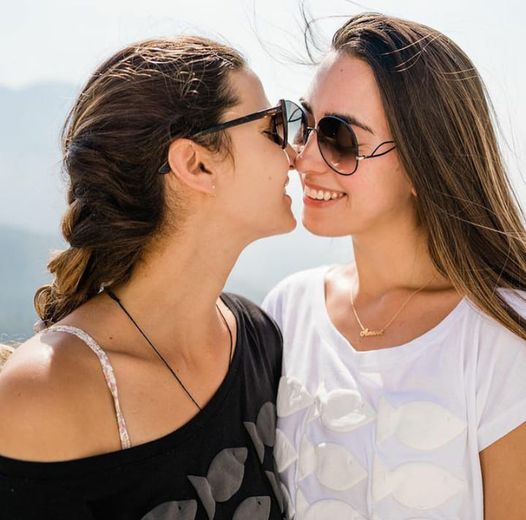

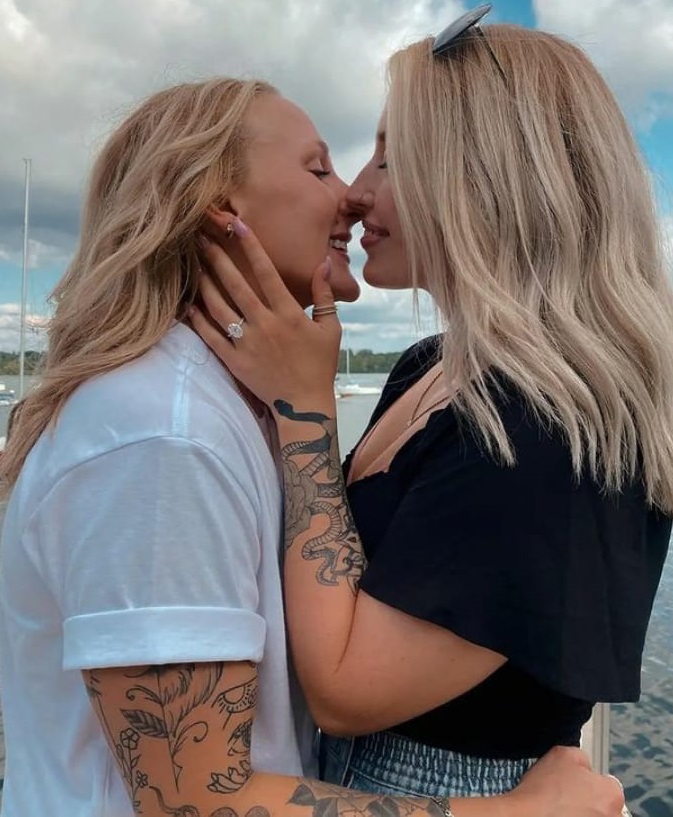

Why Lesbian Visibility Matters
Am I a Lesbian? (Masterdoc)
Advocate: Salute to Amazing LGBTQ Women of 2021
Lesbian Proposal: COVID Edition
Photo Celebration: 30 Years of World's
Largest Lesbian Party
L Word Generation Q:
Season Two Premiere (Entire Episode)
Cute Lesbian Couple: Daily Life in Quarantine
Women Who Changed the Course of LGBTQ History
Sufi
and Anjali: Annoying Each Other During Quarantine
Lesbian Couple Holds Pandemic Wedding at Drive-In Movie
Theatre
LeSbo
NainA: Pure Leabian Page
Lesbians in the 1980s
Strock decided to interview other married women who had
fallen in love with women, "putting up fliers in
theatres and bookstores. Women started contacting me
from across the country – everyone knew someone who knew
someone in this situation." The interviews became a
book, Married Women Who Love Women, and when it came to
writing the second edition, Strock turned to the
internet for interviewees. "Within days," she says,
"more women had contacted me than I could ever actually
speak to."
Late-blooming lesbians – women who discover or declare
same-sex feelings in their 30s and beyond – have
attracted increasing attention over the last few years,
partly due to the clutch of glamorous, high-profile
women who have come out after heterosexual
relationships. Cynthia Nixon, for instance, who plays
Miranda in Sex and the City, was in a heterosexual
relationship for 15 years, and had two children, before
falling for her current partner, Christine Marinoni, in
2004. Last year, it was reported that the British singer
Alison Goldfrapp, who is in her mid-40s, had started a
relationship with film editor Lisa Gunning. The actor
Portia de Rossi was married to a man before coming out
and falling in love with the comedian and talkshow host,
Ellen DeGeneres, whom she married in 2008. And then
there's the British retail adviser and television star,
Mary Portas, who was married to a man for 13 years, and
had two children, before getting together with Melanie
Rickey, the fashion-editor-at-large of Grazia magazine.
At their civil partnership earlier this year the pair
beamed for the cameras in beautiful, custom-made Antonio
Berardi dresses.
The subject has now begun attracting academic attention.
At the American Psychological Association's annual
convention in San Diego in 2010, a session entitled
Sexual Fluidity and Late-Blooming Lesbians showcased a
range of research, including a study by Christan Moran,
who decided to look at the lives of women who had
experienced a same-sex attraction when they were over 30
and married to a man. Moran is a researcher at Southern
Connecticut University, and her study was prompted in
part by an anguished comment she found on an online
message board for married lesbians, written by someone
who styled herself "Crazy".



Karine Jean-Pierre Hosts The L Word Cast
and Creator at White House Press Briefing
Lesbian Highlights of 2022
Cynthia Nixon: Why She
Identifies as Queer
Game-Changing Queer Women to Celebrate
Women's History Month
Commentary: Why I Am
Nobody's Wife
XtraMagazine: No, Lesbians
Are Not Disappearing
Am I Really Proud to Be a Lesbian?
Advocate Magazine: Women of the Year
Butches and Studs
No
More Blues by FreenBecky
100 Lesbian Things To Do Before You Die
Ruthie Berman: Pioneering Lesbian Shares
Her Epic Love Story
Queer Women Who Changed History
Hello It's Me
"I don't understand why I can't do the right thing," she
wrote. "I don't understand why I can't make myself stop
thinking about this other woman." Moran wanted to survey
a range of women in this situation, "to help Crazy, and
others like her, see that they are not abnormal, or
wrong to find themselves attracted to other women later
in life".
She also wanted to explore the notion, she writes, that
"a heterosexual woman might make a full transition to a
singular lesbian identity . . . In other words, they
might actually change their sexual orientation." As
Moran notes in her study, this possibility is often
ignored; when a person comes out in later life, the
accepted wisdom tends to be that they must always have
been gay or bisexual, but just hid or repressed their
feelings. Increasingly researchers are questioning this,
and investigating whether sexuality is more fluid and
shifting than is often suspected.
Sarah Spelling, a former teacher, says she can well
understand how "you can slide or slip or move into
another identity". After growing up in a family of seven
children in Birmingham, Spelling met her first serious
partner, a man, when she was at university. They were
together for 12 years, in which time they were "fully
on, sexually," she says, although she adds that she has
never had an orgasm with a man through penetrative sex.
Spelling is a keen feminist and sportsperson, and met
lesbian friends through both of these interests. "I
didn't associate myself with their sexuality – I didn't
see myself as a lesbian, but very clearly as a
heterosexual in a longstanding relationship." When a
friend on her hockey team made it clear she fancied her,
"and thought I would fancy her too, I was like 'No!
That's not me!' That just wasn't on my compass." Then,
aged 34, having split up with her long-term partner, and
in another relationship with a man, she found herself
falling in love with her housemate – a woman. After
"lots of talking together, over a year or so," they
formed a relationship. "It was a meeting of minds," says
Spelling, "a meeting of interests. She's a keen walker.
So am I. She runs. So do I. We had lots in common, and
eventually I realized I didn't have that with men."
While having sex with a man had never felt uncomfortable
or wrong, it wasn't as pleasurable as having sex with a
woman, she says. From the start of the relationship, she
felt completely at ease, although she didn't immediately
define herself as a lesbian. "I didn't define myself as
heterosexual either – I quite clearly wasn't that. And I
wouldn't define myself as bisexual." After a while she
fully embraced a lesbian identity. "We've been together
for 23 years," she says, "so it's pretty clear that that
was a defining change."


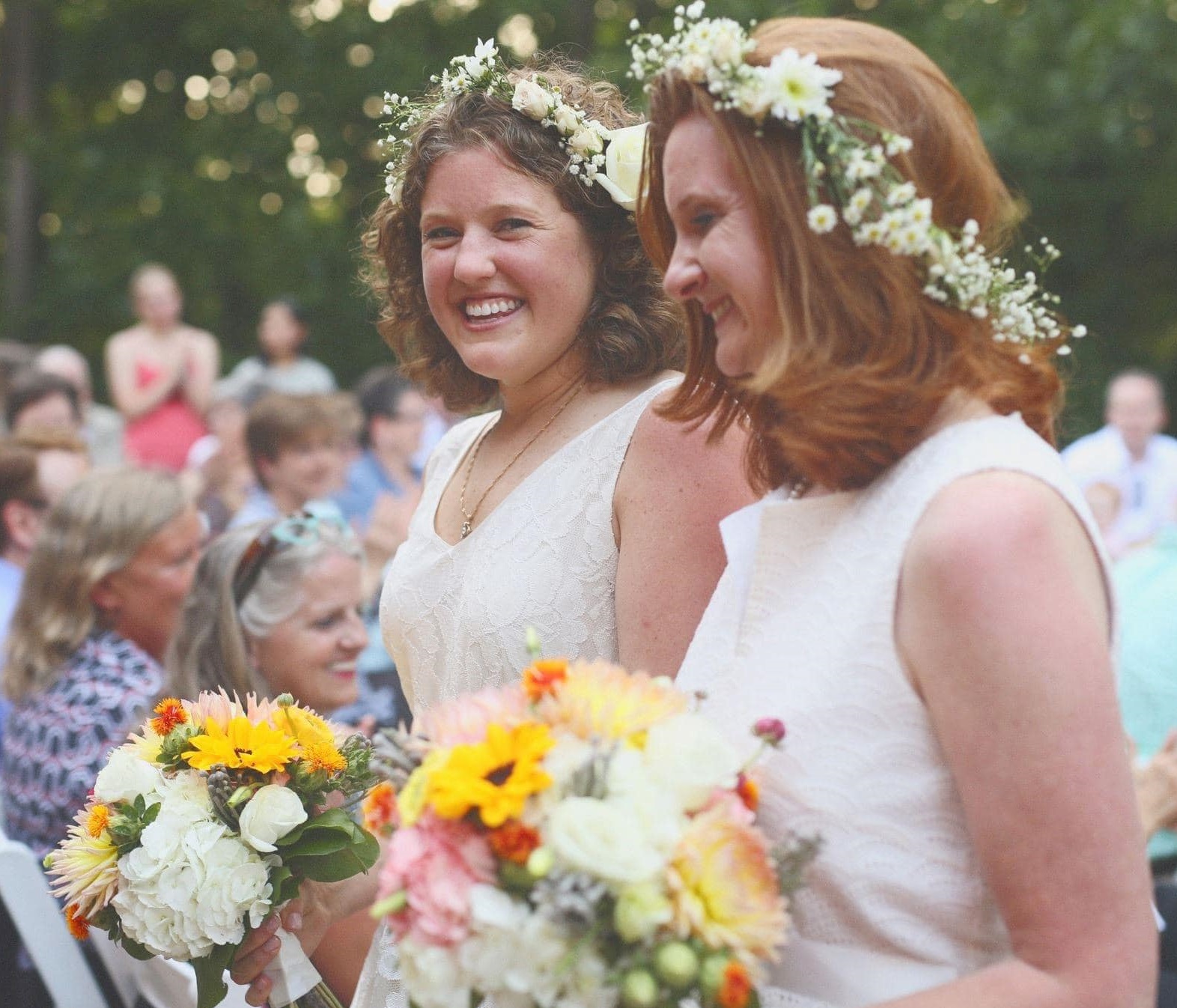
Lesbian Perspective: Hardest Thing About Not Being
Straight
Ten Things Lesbians Hate to Hear
Info: Sexual Orientation
Famous Lesbians
Wikipedia: Definition of Lesbian
Candid Answers to Questions About Lesbian Sex
Tribute to the Women Who
Spoke Up for Lesbian Rights
Honey by Kehlani
Sorry Straights, These Karaoke Songs
Belong to the Lesbians
She Likes Girls
Best Lesbian Scenes from Movies
Dr Lisa Diamond, associate professor of psychology and
gender studies at the University of Utah, has been
following a group of 79 women for 15 years, tracking the
shifts in their sexual identity. The women she chose at
the start of the study had all experienced some same-sex
attraction – although in some cases only fleetingly –
and every two years or so she has recorded how they
describe themselves: straight, lesbian, bisexual, or
another category of their own choosing. In every
two-year wave, 20-30% of the sample have changed their
identity label, and over the course of the study, about
70% have changed how they described themselves at their
initial interview. What's interesting, says Diamond, is
that transitions in sexual identity aren't "confined to
adolescence. People appear equally likely to undergo
these sorts of transitions in middle adulthood and late
adulthood." And while, in some cases, women arrive at a
lesbian identity they've been repressing, "that doesn't
account for all of the variables . . . In my study, what
I often found was that women who may have always thought
that other women were beautiful and attractive would, at
some point later in life, actually fall in love with a
woman, and that experience vaulted those attractions
from something minor to something hugely significant. It
wasn't that they'd been repressing their true selves
before; it was that without the context of an actual
relationship, the little glimmers of occasional
fantasies or feelings just weren't that significant."
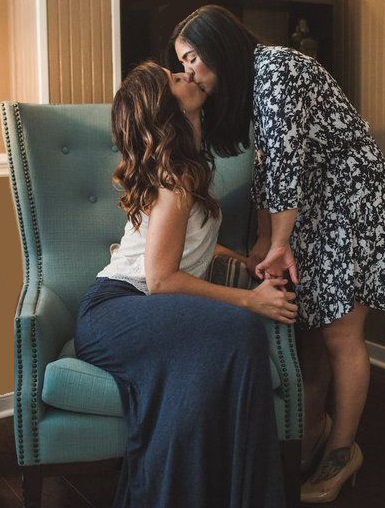

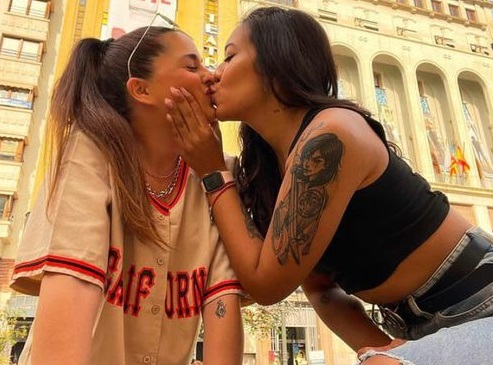
Diamond has a hunch that the possibility of moving
across sexual boundaries increases as people age. "What
we know about adult development," she says, "suggests
that people become more expansive in a number of ways as
they get older . . . I think a lot of women, late in
life, when they're no longer worried about raising the
kids, and when they're looking back on their marriage
and how satisfying it is, find an opportunity to take a
second look at what they want and feel like." This
doesn't mean that women are choosing whether to be gay
or straight, she clarifies. (Diamond's work has
sometimes been distorted by rightwing factions in the
US, who have suggested it shows homosexuality is
optional.) "Every one of the women I studied who
underwent a transition experienced it as being out of
her control. It was not a conscious choice . . . I think
the culture tends to lump together change and choice, as
if they're the same phenomenon, but they're not. Puberty
involves a heck of a lot of change, but you don't choose
it. There are life-course transitions that are beyond
our control."
This was certainly true for Laura Manning, a lawyer from
London, who is now in her late 40s. She had always had a
vague inkling she might have feelings for women, but met
a man at university, "a really gentle man, Jeff, and I
fell in love with him, and for a long time that was
enough to balance my feelings". She married him in her
late 20s, had two children in her early 30s, "and once
I'd got that maternal part of my life out of the way, I
suddenly started thinking about me again. I started to
feel more and more uncomfortable about the image that I
was presenting, because I felt like it wasn't true." In
her late 30s, she began going out clubbing, "coming back
on the bus at four in the morning, and then getting up
and going to work. I was still living with Jeff, and I
just started shutting down our relationship. He knew I
was pushing him away."



You Tube: Notable Lesbians
Am I a Lesbian? (Masterdoc)
Queer Women Who Changed History
Info: LGBTQ Community
Hello It's Me
No
More Blues by FreenBecky
New Research: Lesbians More Accepted Than Gay Men
Music Video: I Wish You Were Gay
Origin of the Word Lesbian
Old Lesbians Give Advice to Young Lesbians
Cathy's Coming Out Story
Video List: Most Famous Lesbians in History
Breanne Williamson: I Am a Lesbian
Queer Women with Tantalizingly Sexy Hands
Queer Girls Googling
Lesbians in the 1980s
The marriage ended, and Manning moved out. She has since
had two long-term relationships with women, and says
she's much happier since she came out, but suspects that
her biological urge to have children, and her genuine
feelings for Jeff, made her marriage inevitable on some
level. "The thought of sex with a man repels me now, but
at the time, when I was in my marriage, I didn't feel
that, and I didn't feel I was repressing anything. The
intensity of feeling in my relationship with Jeff
overcame and blanketed my desires for women."
Sexual fluidity occurs in both men and women, but it has
been suggested that women are potentially more open and
malleable in this regard. Richard Lippa, professor of
psychology at California State University, Fullerton,
has carried out a variety of studies that have led him
to the conclusion that, "while most men tend to have
what I call a preferred sex and a non-preferred sex . .
. with women there are more shades of grey, and so I
tend to talk about them having a more preferred sex, and
a less preferred sex. I have definitely heard some women
say, 'It was the person I fell in love with, it wasn't
the person's gender,' and I think that that is much more
of a female experience than a male experience.
"I've never had a straight man say to me, at age 45, I
just met this really neat guy and I fell in love with
him and I don't like men in general, but God, this guy's
so great that I'm going to be in a relationship with him
for the next 15 years." In Diamond's study, around a
quarter of the women have reported that gender is
largely irrelevant in their choice of sexual partners.
"Deep down," said one woman, "it's just a matter of who
I meet and fall in love with, and it's not their body,
it's something behind the eyes."
When Tina Humphrys, 70, first fell in love with a woman,
she didn't define herself as a lesbian, "I just thought:
'It's her.'" Humphrys was in her mid-30s, had two
children, and was coming out of a horrible second
marriage. "I hated my life," she says. "The four
bedrooms, the children – well, I didn't hate them, they
just bored me to tears. I used to lie on the couch and
my eyes would fill with tears as they had their naps."

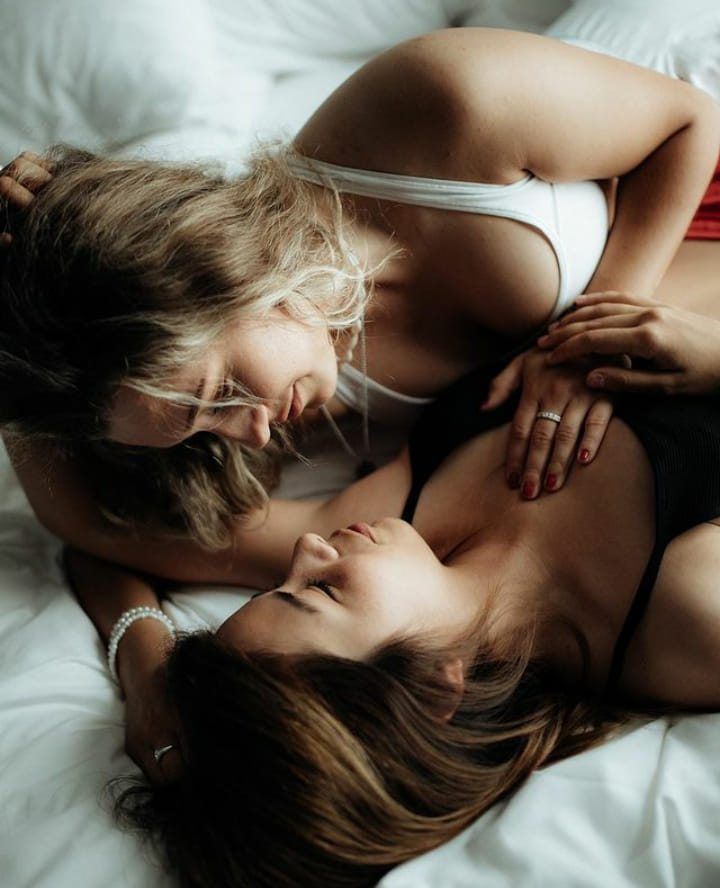

Epochalips: Smart
Lesbian Commentary
Video List: Most Famous Lesbians in History
Edie and Amanda: First Time
Info: Sexual Orientation
Incredible Lesbians Who are Loud, Proud
and Making the World a Better Place
How The L Word Changed Lesbian Television
Endless Love: Audrey and Camille
Famous Black Lesbians You Should Know
Ruth and Jade
Info: Women and Feminism
Metro Station: I Think She Likes Girls
Paige and Holly: Hugs and Cuddles
No
More Blues by FreenBecky
She had found women attractive in the past, "but I think
women do, don't they? You look and you think – that
dress looks fabulous, or isn't she looking slim, or
doesn't she look pretty. But you don't necessarily put
sexual feelings on it." Then she went to university as a
mature student, joined a women's group, and started to
fall for one of the other members. "It was a bit of a
shock to find that I was attracted sexually to this
woman, but then it was also a decision to leave men. It
was a decision to leave a particularly oppressive and
restrictive way of living and try to live differently."
She moved into a "commune-type place", and had
non-monogamous relationships with women for a while,
before settling down with her current partner of more
than 30 years. While she had had "a very active sex life
with men", she enjoyed sex with women much more. "I was
once doing a workshop with a woman who used to tear
hideous things that had been said about women out of the
paper, and she had a piece about this blonde model who
had romped with a lesbian – because they always romp,
don't they? – and she said: 'It wasn't proper sex, it
was just a load of orgasms.'" Humphrys laughs
uproariously. "I think that just about sums it up,
doesn't it?"
Beyond the sex, Humphrys found a connection that was
more intense "on every level" than any she had found
with a man. Strock echoes this view. "I've run workshops
with straight women, and I've asked them, did you ever
feel those sky rockets go off, or hear the music
playing, when you fell in love with that significant
other? And very few raise their hands. And then I went
to a gay women's group, and I said, how many of you have
ever felt the same? And almost all the hands went up. So
connections with women are very different to connections
between women and men."
The psychotherapist and writer, Susie Orbach, spent more
than 30 years with the writer Joseph Schwartz, and had
two children with him, before the partnership ended, and
she subsequently formed a happy, ongoing relationship
with the novelist Jeanette Winterson. Orbach says that
the initial love connection between mother and daughter
makes lesbian feelings in later life unsurprising. "If
you think about it," she says, "whose arms are you first
in, whose smells do you first absorb, where's that
body-to-body imprint? I mean, we're still not really
father-raised, are we, so it's a very big journey for
women to get to heterosexuality . . . What happens is
that you layer heterosexuality on top of that bond. You
don't suddenly switch away from it. You don't give up
that very intimate attachment to a woman."



I Think I Might Be a Lesbian
She Likes Girls
Lesbian Coming Out at 40
Belly Kisses by Rachel Wiley
Paige and Holly: I Wanna Marry You
Lesbian Tunes: New Sapphic Pride Anthems
Noora, Are You a Lesbian?
Mermaid Tavern
100 Lesbian Things To Do Before You Die
Queer YouTubers: Losing Your Virginity
Awesome Things About Lesbian Relationships
Hello It's Me
Of course, the notion that your sexuality might shift
entirely isn't welcomed by everyone; as Diamond says,
"Even though there's more cultural acceptance than there
was 20 years ago, same-sex sexuality is still very
stigmatized, and the notion that you might not know
everything there is to know about something that's so
personal and intimate can terrify individuals. It's
really hard for people to accept." That's why the
writing and research in this area is so important. When
the first edition of Strock's book was published, "a
woman came up to me at one of my early speaking
engagements, clutching the book and sobbing," she says.
"She thought she was the only married woman ever to have
fallen in love with another woman, and had no one to
talk to, didn't know where to turn. And she had decided
that the best thing was to kill herself on a night when
she knew her husband and children were going to be out
late. She'd planned her suicide. She was coming home
from work for what she thought would be the last time,
and she passed a bookstore, and they were putting my
book in the window, and when she realized that she
wasn't the only one, she chose to live".
The late-blooming lesbians I spoke to had all found
happiness on their different paths. Strock is still a
lesbian – and also still married to her husband, who
knows about her sexuality. "He would never throw me
away, and I would never throw him away," she says, "so
we've re-defined our relationship. I'm a lesbian, but we
share a house, we have separate rooms, we have two
grandchildren now, and our situation is not unique."
Most of the other women I spoke to were in happy,
long-term relationships with women, and had found a
contentment that they'd never experienced in their
previous relationships.
"While some people find change threatening," Diamond
says, "others find it exciting and liberating, and I
definitely think that for women in middle adulthood and
late life, they might be the most likely to find sexual
shifts empowering. We're an anti-ageing society. We like
people to be young, nubile and attractive. And I think
the notion that your sexuality can undergo these really
exciting, expansive possibilities at a stage when most
people assume that women are no longer sexually
interesting and are just shutting down, is potentially a
really liberating notion for women. Your sexual future
might actually be pretty dynamic and exciting – and
whatever went on in your past might not be the best
predictor at all of what your future has in store."
[Source: Kira Cochrane, The Guardian, July 2010]

When Abbie Met Emmy: Lesbian Romance
Short Film
Gal Pals and Compulsory
Heterosexuality
Lesbian Literature
Breanne Williamson: I Am a Lesbian
Butches and Studs
Tribute to the Women Who
Spoke Up for Lesbian Rights
Honey by Kehlani
LeSbo
NainA: Pure Leabian Page
Jess and Emily: How Lesbians Do It
Info: Skirt Club
Queer Women Who Changed History
Sorry Straights, These Karaoke Songs
Belong to the Lesbians
Epic Journey to America's Last Lesbian Bars
Awesome Songs About Women Crushing on Women
Epochalips: Smart
Lesbian Commentary
Lesbians in the 1980s
Dyke vs Lesbian
1965 Report: Female Homosexuality
Am I a Lesbian? (Masterdoc)

HOME
QUEER CAFE
│ LGBTQ Information Network │ Established 2017 |




































































































































































